1961-01-01
To my knowledge, the only keys to the nymphal stages of the European species of Pentatomoidea (shield bugs) appear in Shchytnyky by V. G. Puchkov (1961), volume 21 of Fauna of Ukraine. Although the species included were only intended to encompass the fauna of Ukraine, these keys can still be useful for the rest of Europe. With this translation, I hope to make these keys available to a wider European audience.
Lars Willighagen ![]() 0000-0002-4751-4637
0000-0002-4751-4637
Puchkov, V. G. (1961). Shchytnyky. In Fauna of Ukraine (Vol. 21, Issue 1). Naukova dumka. http://www.izan.kiev.ua/fau-ukr/vol21iss1.htm
Пучков, В. Г. (1961). Щитники. In Фауна України (Vol. 21, Issue 1). Наукова думка. http://www.izan.kiev.ua/fau-ukr/vol21iss1.htm
Wing rudiments are not developed
or outlined very weakly. 2
Wing rudiments are well developed. 4
The head is usually almost
vertical, wrinkled in front, the back of the head completely smooth. The
rear edge of the mesonotum is smoothly curved, without protrusions (Fig.
18, I). Instar I
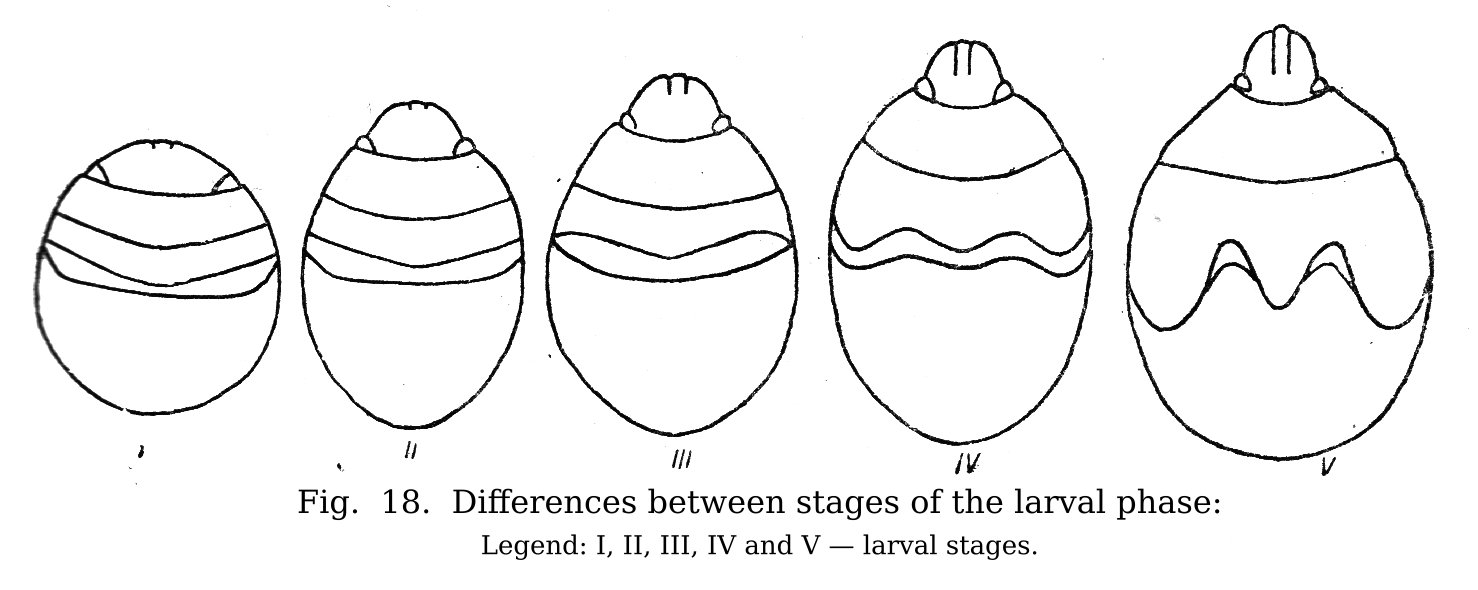
The head is often slightly tilted, wrinkled or dotted. The rear edge
of the mesonotum with a more or less clearly defined shield rudiment.
3
The shield rudiment is weakly
defined, the rear edge of the mesonotum is smooth, not curved near the
mediolateral lines. The mesonotum is wider in front of the mediolateral
line than behind it, i.e. it becomes lightly narrower (Fig. 18, II).
Smaller. Instar II
The shield rudiment is clearly defined, the rear edge of the
mesonotum is straightened near the midlateral lines (near the main
corners of the shield). The mesonotum is usually narrower in front of
the mid-lateral line than behind it, i.e. it becomes slightly wider
(Fig. 18, III). Bigger. Instar
III
The tops of the hemelytra do not
reach the posterior edge of the first tergite of the abdomen (Fig. 18,
IV). Instar IV
The tops of the hemelytra usually reach tergites III-IV (Fig. 18, V).
Instar V
The distance between the ostioles of
the abdominal gland on the first ESES is shorter than on the second
(Fig. 23, 1). The proboscis is closer to the base than to the top of the
head (Fig. 28, 2, b). Plataspidae
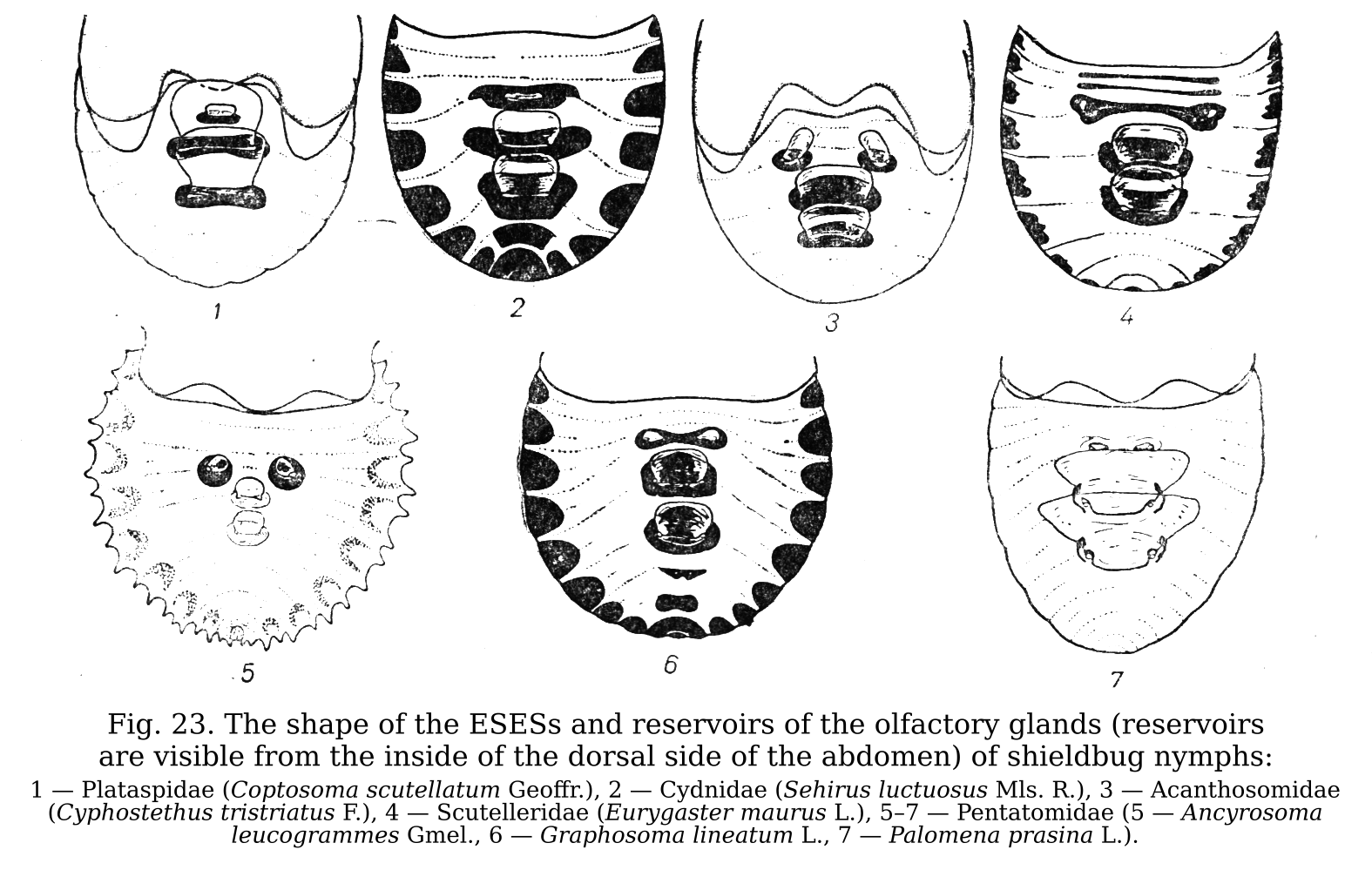
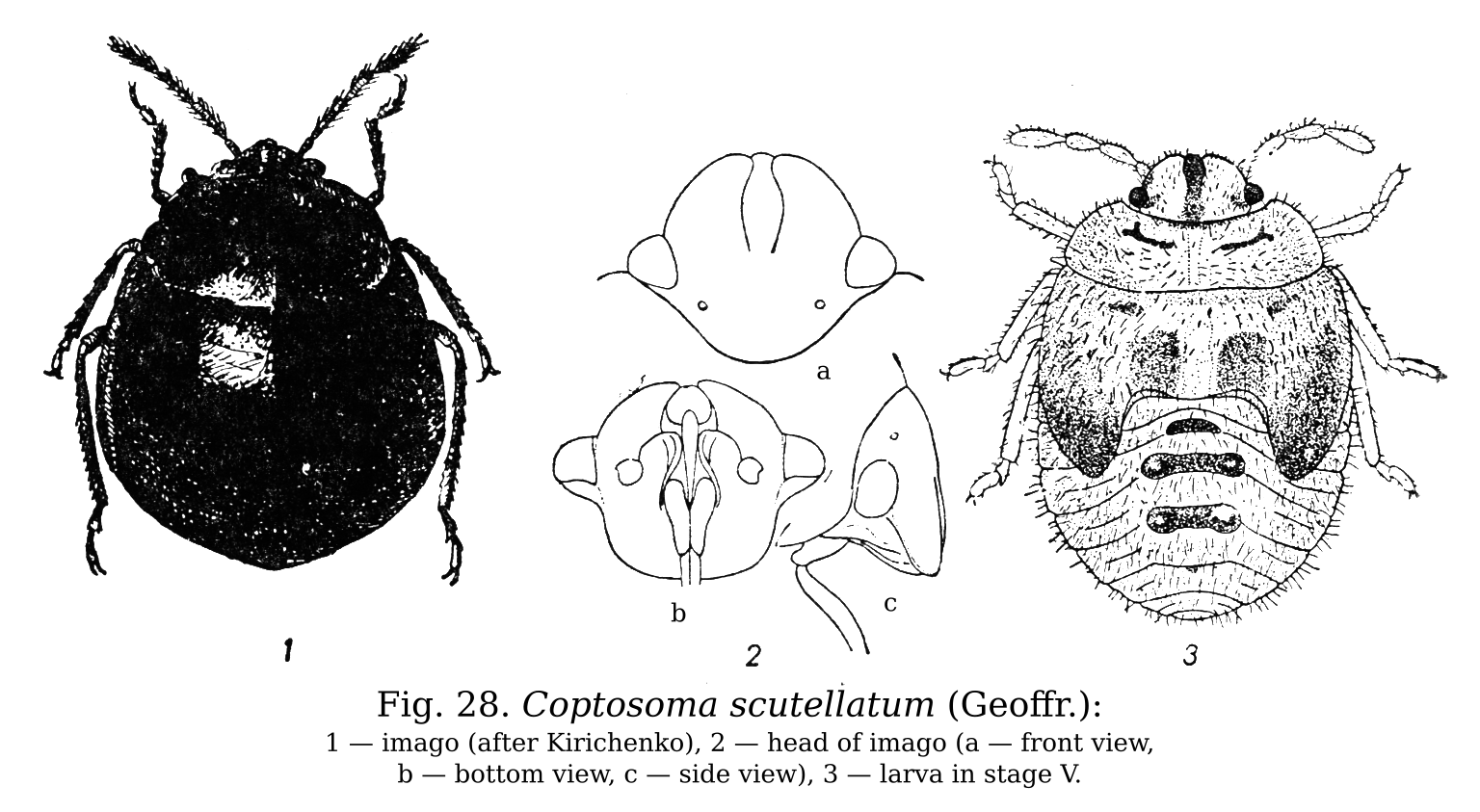
The distance between the ostioles on the first ESES is not shorter
(or barely shorter) than on the second. The proboscis is closer to the
top than to the base of the head (Fig. 5, 1).
2
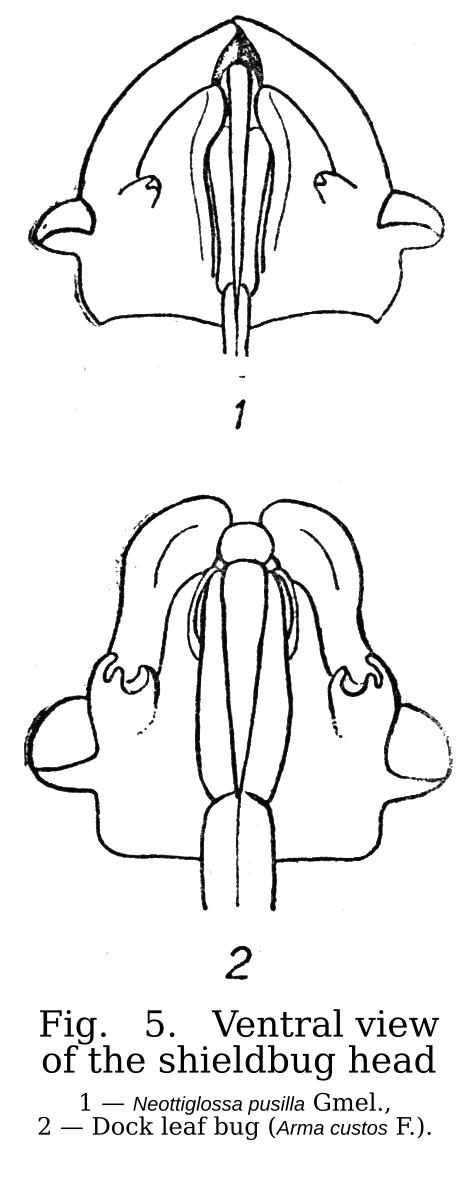
The distance between the ostioles on
the first ESES is much larger than on the second, and if the first ESES
is split, the abdomen is completely unpunctuated.
3
The distance between the ostioles on the first ESES is as long (Fig.
23, 7) or almost as long (Fig. 23, 6) as on the second, and if
significantly longer, then the first ESES is split in two (Fig. 23, 5).
4
The first ESES is split in two and
looks like two ovals with a slit-shaped hole of the abdominal gland
(Fig. 23, 3). The abdomen is completely unpunctuated. The tylus extends
to the top (Fig. 30, 1). Living on trees and shrubs.
Acanthosomidae

The first ESES is continuous, shaped like a femur (Fig. 23, 4), and
even if its dark color washed away (IV–V), then the contour is clearly
outlined by the punctuation. The abdomen has black punctuation. The
tylus is not extended, often narrowed. Living on herbaceous plants.
Scutelleridae
Tibiae without spines, sometimes with
thin or very short spines (Vilpianus). The contour of parasegmental
spots and ESESs in the older stages is often blurry, and if they are
clearly defined, the proboscis is very thick (Asopinae) or the first
ESES is sickle-shaped with ostioles placed close together (Eurydema).
Abdomen often with black punctuation. Pentatomidae
Tibiae covered with long, thick spines. Parasegmental spots and ESESs
are usually clearly defined in all stages (Fig. 23, 2). Abdomen
completely unpuctuated (except in Thyreocoris).
Cydnidae
Plataspinae Dallas, 1851
Coptosoma Lap., 1832
Coptosoma scutellatum (Geoffroy, 1785)
= Cimex scutellatus Geoffroy, 1785
= Coptosoma globus Fieber, 1861
= Acanthosomida Stal, 1864
= Acanthosomidae Leston, 1953
Thorax densely and evenly covered with
large, black punctuation. Parasegmental spots on the edges of the
abdomen are large, solid or shaped like a semicircle (when the dark
color in the middle is blurred), and the stripes at the edges of the
segments (in side view) are continuous, the same width along their
entire length (Fig. 29, 1). The edge of the juga is bordered by sharp,
very low ridges. Acanthosoma
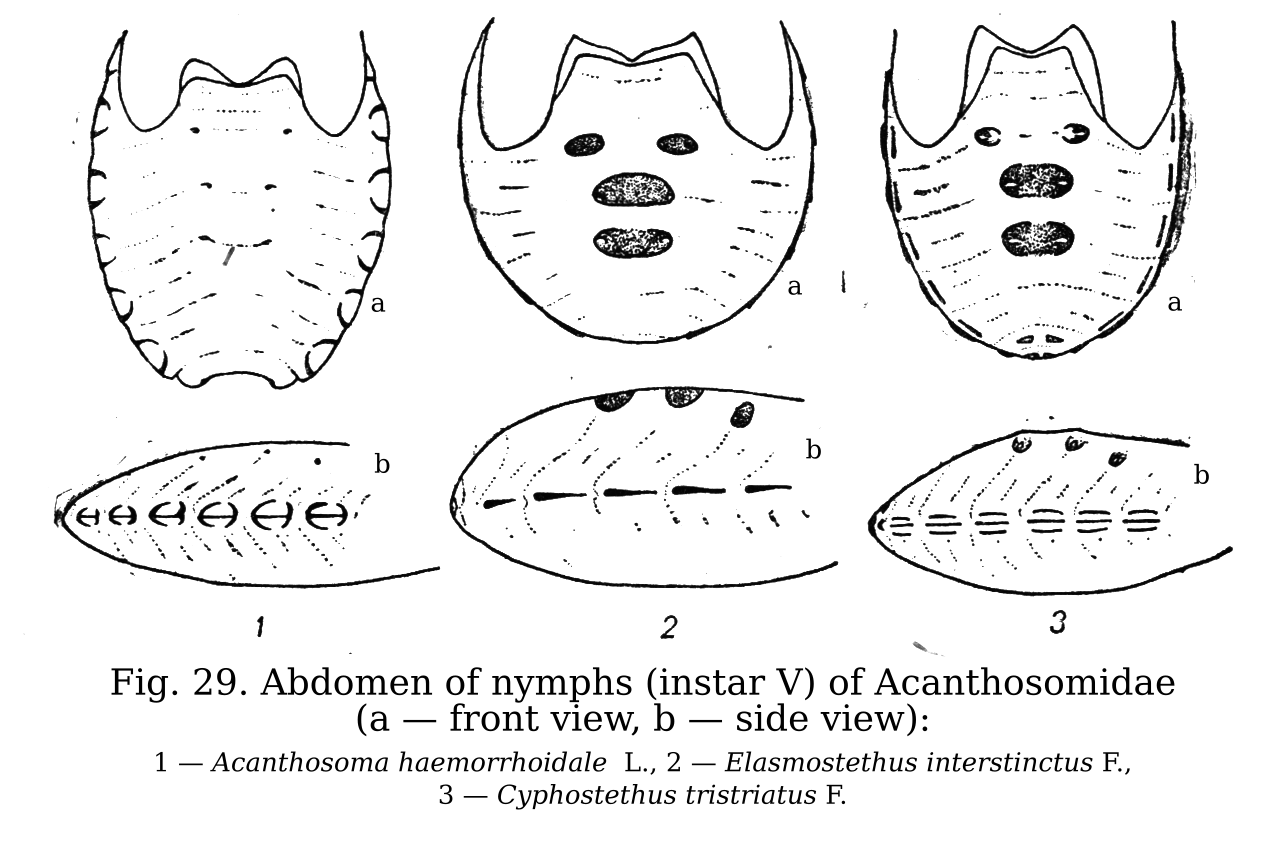
Thorax unpunctated or with only a few irregularly scattered black
dots. Parasegmental spots on the edges of the abdomen look like one
longitudinal stripe, stroke or wedge, behind wider than in front (Fig.
29, 2) or three such lines (Fig. 29, 3) (side view). The outer edge of
the juga is bordered by a rounded, rather high ridge.
2
On the outer edges of each segment of
the abdomen there is only one black line (Fig. 29, 2).
3
On the edges of each segment of the abdomen there are three
converging continuous black lines, the same width along the entire
length (Fig. 29, 3). Cyphostethus
There is no transverse dark spot at
the base of tergite VII. Bigger. Elasmostethus
At the base of tergite VII there is a sharply delineated transverse
black or dark brown spot. Smaller. Elasmucha
Acanthosoma Curt., 1824
Acanthosoma haemorrhoidale (Linné, 1758)
= Cimex haemorrhoidalis Linné, 1758
Elasmostethus Fieb., 1860
Elasmostethus interstinctus (Linné, 1758)
= Cimex interstinctus Linné, 1758
= Elasmostethus dentatus Fieber, 1861
Elasmucha Stal, 1864
The body is broadly oval, without
longitudinal dark stripes on the head and thorax and without a light
stripe on the abdomen. Antennae are thinner and longer; the hairs on
them are elevated, of almost the same thickness, and their length is not
greater than the thickness of the segments of the antennae (IV–V).
E.
ferrugata
The body is elongated oval, with longitudinal dark stripes on the
head and thorax, especially sharply visible on the pronotal disc, with a
light stripe along the middle of the abdomen. Antennae are thicker and
shorter, with protruding hairs of different lengths; the length of many
hairs is greater than the thickness of antennal segments (III–V).
E.
betulae
Elasmucha ferrugata (Fabricius, 1787)
Bilberry shieldbug
= Cimex ferrugatus Fabricius, 1787
Elasmucha betulae (De Geer, 1773)
Parent bug
= Cimex betulae De Geer, 1773
= Elasmostethus griseus Fieber, 1861
= Elasmucha interstinctus Reuter, 1888
Cyphostethus Fieb., 1860
Cyphostethus tristriatus (Fabricius, 1787)
= Cimex tristriatus Fabricius, 1787
Burrowing bugs
= Thyreocoridae Reuter, 1910
All abdominal spiracles are somewhat
distant from the dark parasternite spots located along the edge of the
abdomen (Fig. 33, 1). At least on the edge of the head and thorax,
bristles stick out. Cydninae
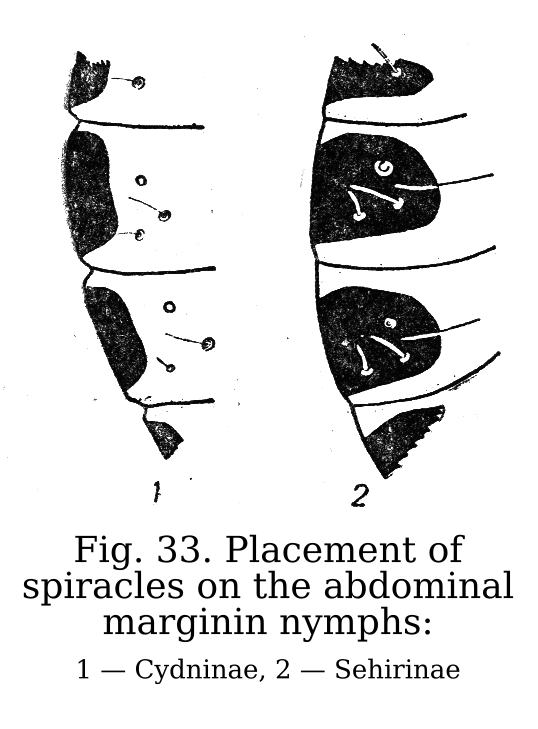
All abdominal spiracles are placed directly on the parasternite spots
(Fig. 33, 2). The body is completely bare.
2
There are no transverse stripes on
the first two tergites. The distance between the ostioles on the second
and third ESESs is two to three times smaller than the width of the
ESESs, and the ostioles are point-like, almost imperceptible (Fig. 32,
2). The first ESES is noticeably longer and wider than the first.
Sehirinae

On I and II tergites there is a wide, dark, interrupted stripe in the
middle. The distance between the ostioles on the second and third ESESs
is only slightly smaller than the width of the ESESs, and the ostioles
on them are clearly visible (Fig. 32, 3). The first ESES is much shorter
and not wider than the second. Corimelaeninae
Corimelaeninae Uhler, 1872
= Thyreocorinae Van Duzee, 1907
Thyreocoris Schrank
Thyreocoris scarabaeoides (Linné, 1758)
= Cimex scarabaeoides Linné, 1758
Cydninae Dallas, 1851
The front tibias are saber-shaped;
the tarsi are attached approximately in the middle of the tibia (Fig.
34, 1). Stibaropus
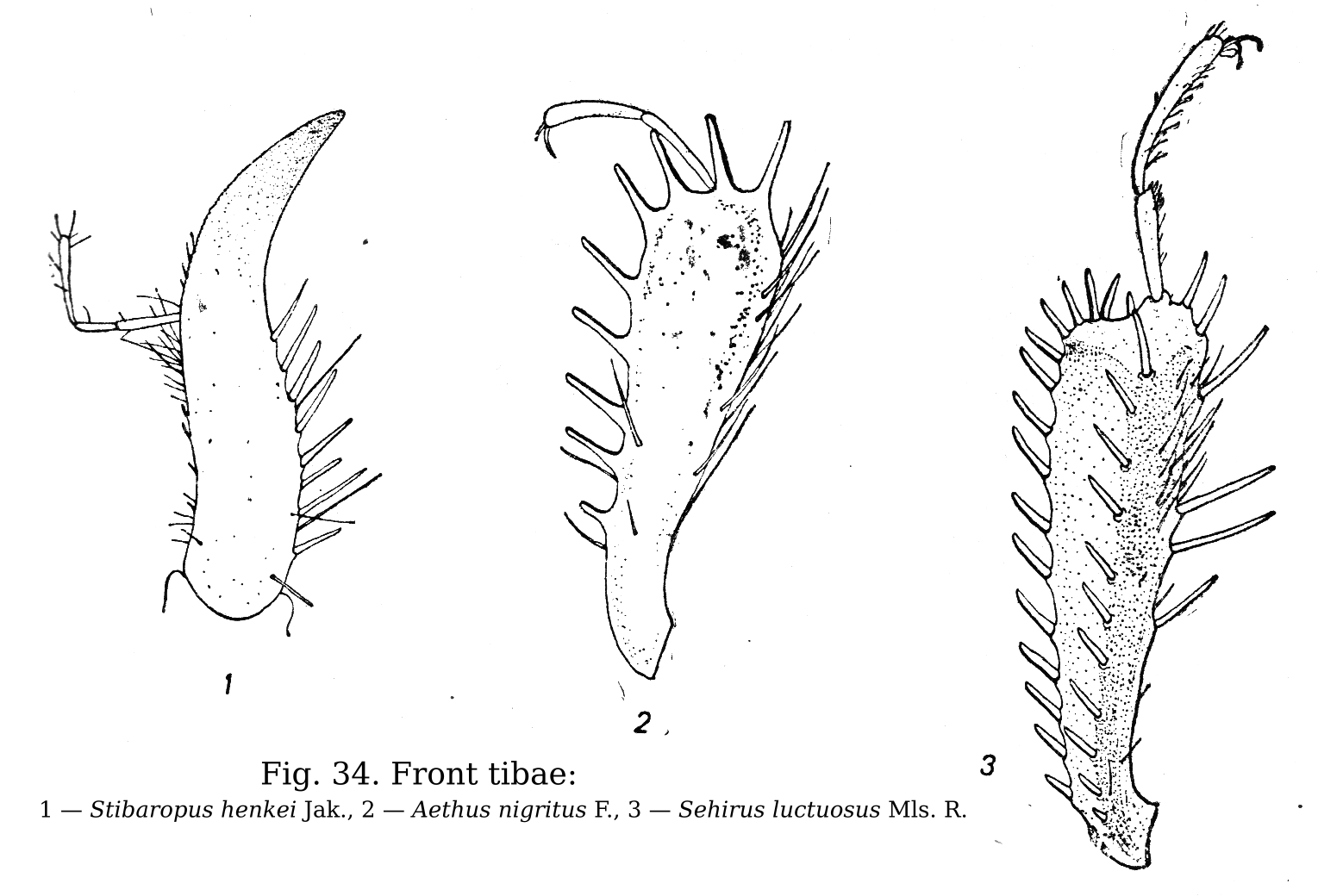
The front tibias are of a different shape, and the tarsi are always
attached near the top of the tibia. 2
The outer edges of the head are
covered with spines and bristles (Fig. 38, 2, a, b). Dark transverse
stripes on tergites I and II are usually wider than the first ESES. The
abdomen is pale, grayish or yellowish, rarely (stages I–II) with a
pinkish tint. 3
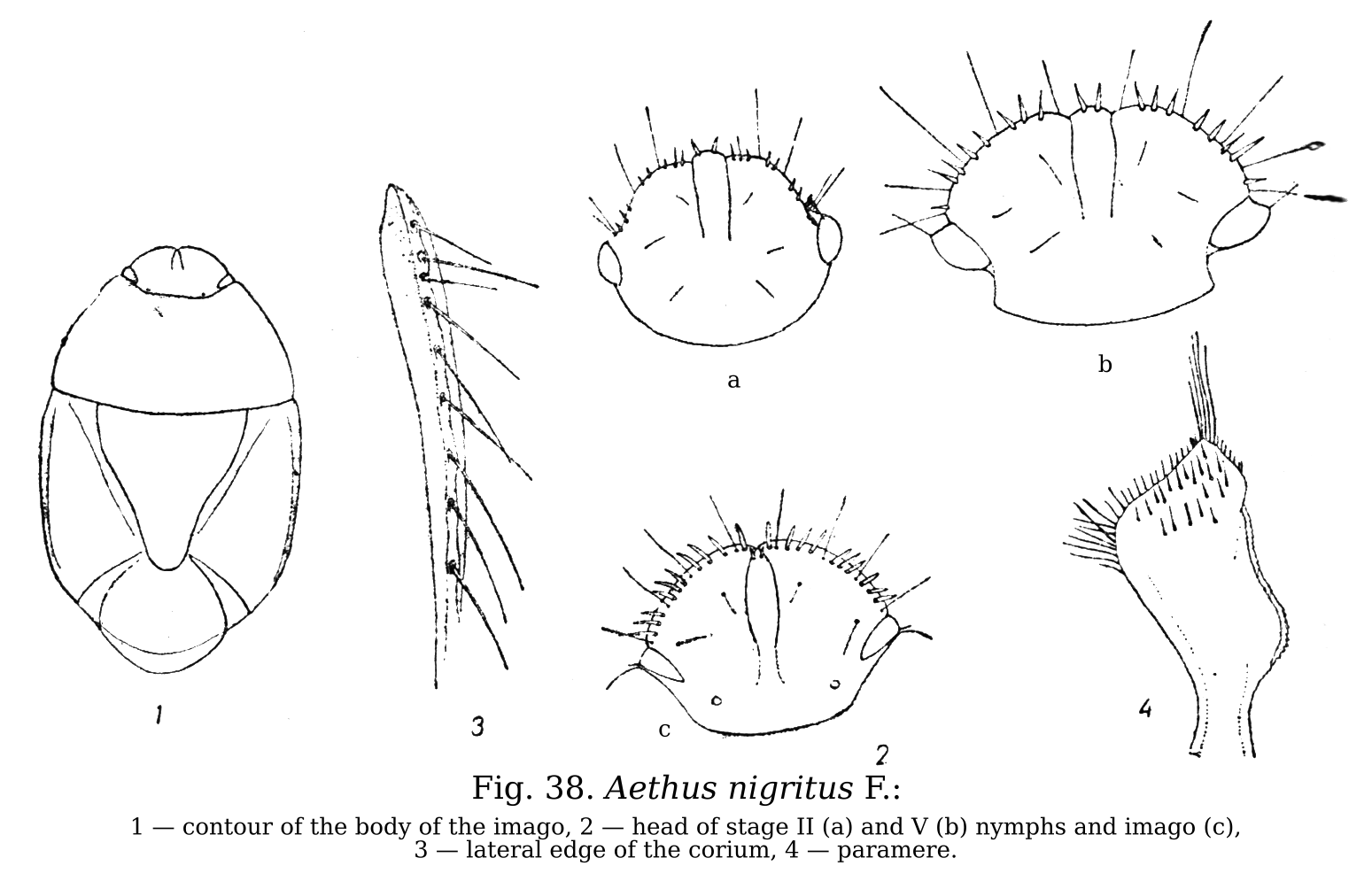
The outer edges of the head are covered only with bristles.
4
The body is covered with protruding
hairs. Byrsinus
The upper surface of the body is hairless, with setae located only on
its edges. Aethus
The bristles on the edges of the head
and thorax are thin and long, the same as the length of the third
segment of the antennae. The stripes on tergites I and II are wider than
the ESESs. The abdomen is grayish. Geotomus
The bristles on the edges of the head and thorax are thick,
noticeably shorter than the length of the third segment of the antennae.
Dark stripes are absent or very narrow on tergites I and II. The abdomen
is usually red. Cydnus
Stibaropus Dall., 1851
Stibaropus henkei (Jakovlev, 1874)
= Pachycnemis henkei Jakovlev, 1874
Byrsinus Fieb., 1860
Byrsinus fossor (Mulsant & Rey, 1865)
= Cydnus fossor Mulsant & Rey, 1865
Aethus Dallas, 1851
= Cydnus Fabricius, 1775
= Microporus Uhler, 1875
Tylus on the top with two short
spines. The hairs on the edges of the head and thorax are shorter and
less frequently placed, no longer than the third segment of the
antennae; on the edges of the abdomen they are not there at all.
A.
nigritus
Tylus on top with two long bristles. The hairs on the edges of the
head, thorax and abdomen are longer and denser, they are on average
twice as long as the third segment of the antennae.
A.
flavicornis
Aethus nigritus (Fabricius, 1794)
= Cimex nigrita Fabricius, 1794
Aethus flavicornis (Fabricius, 1794)
= Cimex flavicornis Fabricius, 1794
Geotomus Mulsant & Rey, 1866
Geotomus punctulatus (Costa, 1847)
= Cydnus punctulatus Costa, 1847
Cydnus F., 1803
Cydnus aterrimus (Förster, 1771)
= Cimex aterrimus Förster, 1771
= Brachypelta aterrima Fieber, 1861
= Cydnus aterrima Stal, 1864
Sehirinae Stal, 1872
It is found on or near Galium plants.
The body is strongly convex, the head and thorax are the same color,
black or brown. Abdomen above without red transverse stripes, and if
with pinkish stripes (younger stages), then they are very thin and go
along the intertergite borders, and not across the tergites.
Legnotus
Not related to Galium plants. The body is somewhat flattened or the
head and thorax are two-colored. 2
Abdomen gray with transverse reddish
stripes (II–V) or all dark gray without stripes (V). The thorax is
single-colored from above, black or dark brown; the body is somewhat
flattened. 3
Abdomen of a different color, always without transverse red stripes
(II–V). Thoraces are often two-colored (IV–V). The body is convex.
Canthophorus
Transverse red stripes bifurcate on
the sides of the abdomen (II–V) or disappear altogether. Paratergite
spots are much smaller than half of the third ESES (III–V). Bigger.
Sehirus
Transverse red stripes connect oppositely placed paratergite spots,
do not bifurcate on the sides of the abdomen and are always clearly
defined. Paratergite spots are larger, almost equal to half of the third
ESES (III–V). Smaller. Ochetostethus
Legnotus Schiödte, 1849
= Gnathoconus Fieber, 1861
The head and thorax are pale brown
(I–III) or brown (III–V), rarely almost black (V). The body is
completely naked from above. L. limbosus
The head and thorax are brown (I–II) or black (III–V). The thorax is
covered from above with very short (side view and in the light)
protruding hairs. L.
picipes
Legnotus limbosus (Geoffroy, 1785)
Bordered shieldbug
= Cimex limbosus Geoffroy, 1785
= Cimex albomarginatus Goeze, 1778
Legnotus picipes (Fallen, 1807)
Heath shieldbug
= Cydnus picipes Fallen, 1807
Sehirus Amyot & Serville, 1843
Sehirus luctuosus Mulsant & Rey, 1866
Sehirus morio (Linné, 1761)
= Cimex morio Linné, 1761
Canthophorus Mulsant & Rey, 1866
The abdomen is yellowish, greenish or
whitish (II–V); the thorax is two-colored from above (IV–V).
2
The abdomen is red or ocher (II–V), the thorax is two-colored (I–V).
3
Abdomen yellowish (I–V); the lateral
edges of the pronotum are white (IV–V); the width of the first ESES is
much smaller than the distance from its lateral edge to the edge of the
abdomen. (III–V). C.
bicolor
The abdomen is greenish (II–V); lateral edges of pronotum black
(II–V); the width of the first ESES is not greater or slightly greater
than the distance from its lateral edge to the edge of the abdomen
(III–V). C.
sexmaculatus
The head and thorax are bluish, the
abdomen is red. C.
dubius
The head and thorax are black, the abdomen is ocher.
C.
biguttatus
Canthophorus bicolor (Linné, 1758)
Pied shield bug
= Cimex bicolor Linné, 1758
Canthophorus sexmaculatus (Rambur, 1842)
Rambur's pied shieldbug
= Cydnus sexmaculatus Rambur, 1842
Canthophorus dubius (Scopoli, 1763)
= Cimex dubius Scopoli, 1763
Canthophorus biguttatus (Linné, 1758)
Cow-wheat shieldbug
= Cimex biguttatus Linné, 1758
Ochetostethus Fieb., 1861
Ochetostethus nanus (Herrich-Schäffer, 1834)
= Cydnus nanus Herrich-Schäffer, 1834
= Ochetostethus pygmaeus Fieber, 1861
Jewel bugs
= Scutelleridae Reuter, 1912
Abdominal spiracles (except spiracles
of segment II) are placed directly on parasternite dark spots. The body
is covered with more or less long hairs (Odontoscelini).
2
All abdominal spiracles are located near the parasternite spots. The
body is bare or covered with very short hairs.
3
The hairs on the body are several
times longer than the diameter of the eye. The head is obtusely rounded
in front of the eyes without sharp-angled protrusions.
Irochrotus
The hairs on the body are no longer or slightly longer than the
diameter of the eye. The head in front of the eyes with sharply defined
protrusions, transversely oval from the front (Fig. 53, 4).
Odontoscelis
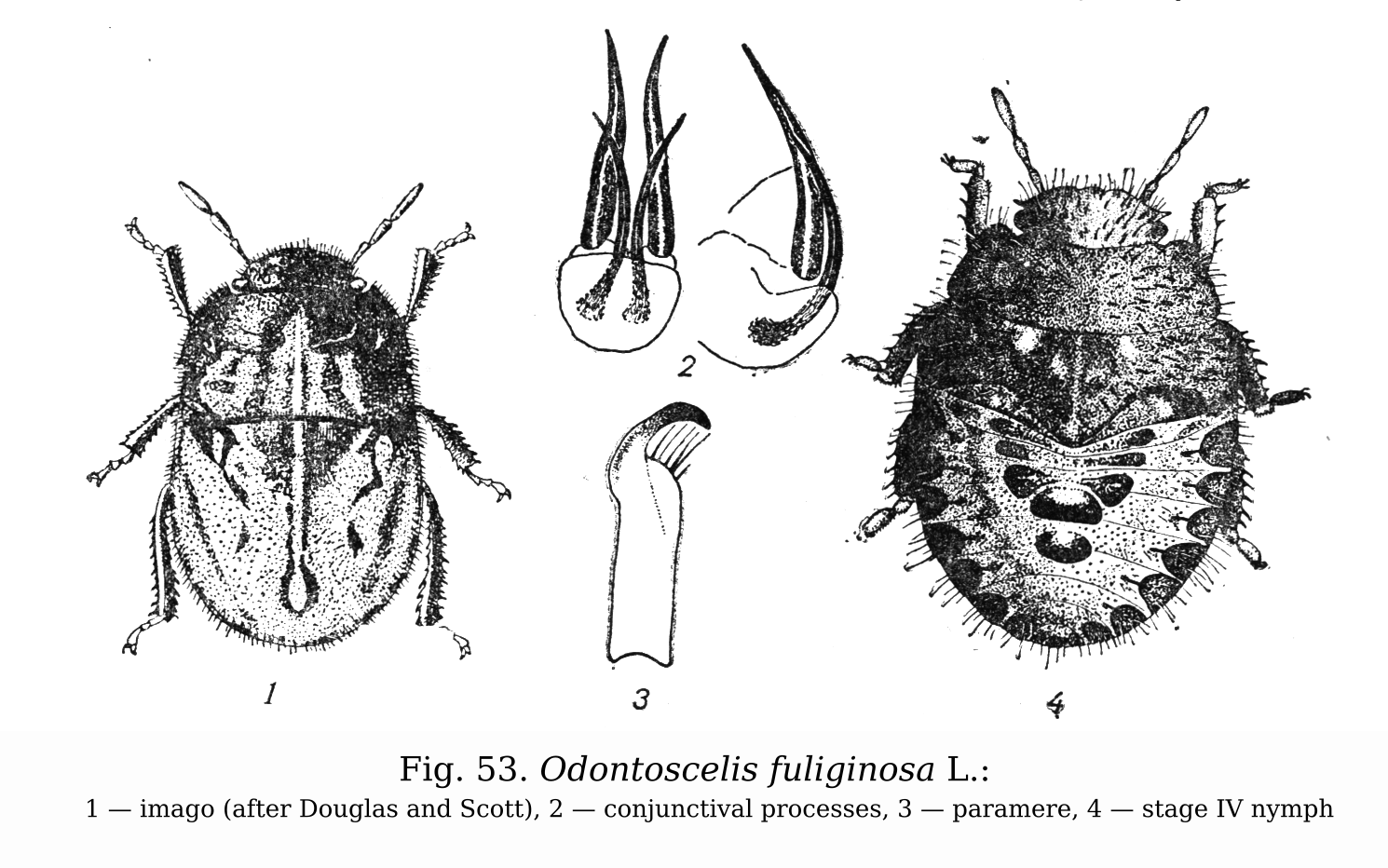
Body with very short or tangled
appressed hairs, well visible when viewed from the side and in the light
(Odontotarsini). 4
The body is completely bare (Eurygastrini).
5
The head is almost rectangular from
the front (Fig. 56, 2), the eyes are round, sticking out (III–V). The
body is covered with appressed tangled hairs (II–V).
Phimodera
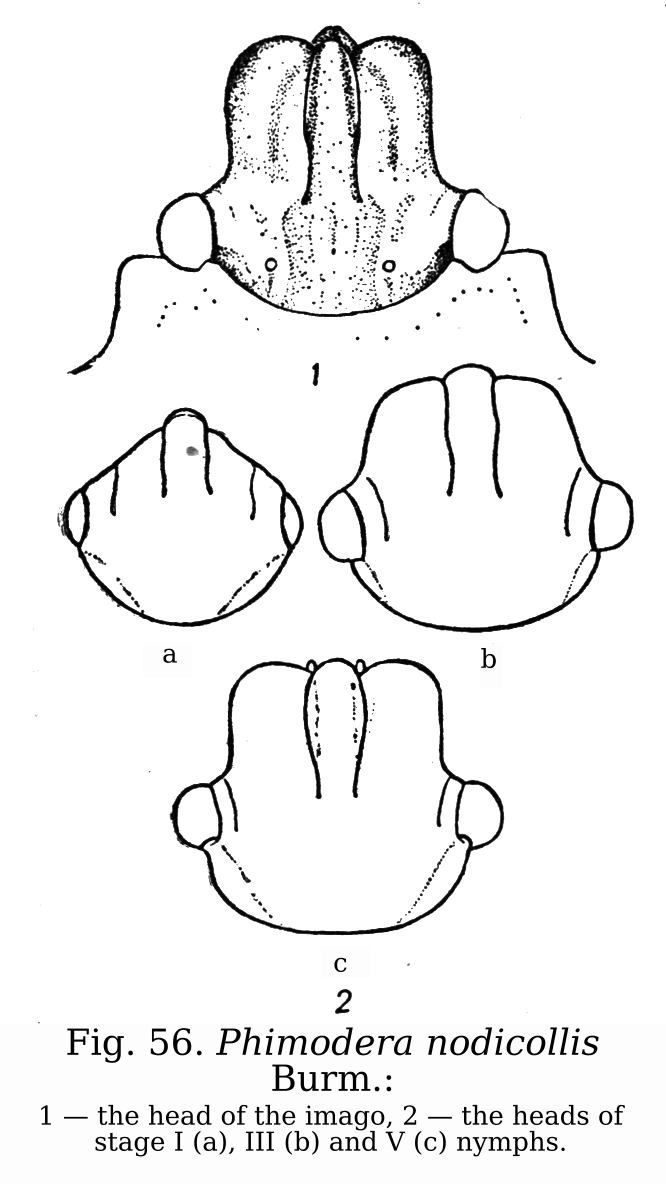
The head is rectangularly rounded from the front, the eyes are
sessile (I–V). The body is covered with very short protruding hairs
(II–V). Odontotarsus
On Boraginaceae plants. The body is
oval (I), ovoid (II–III) or short oval (IV–V). The flattened lateral
edges of the pronotum are off-white (I–III). Body with whitish or
off-white spots and tubercles (IV–V). Psacasta
On Poaceae. The body is almost round (I), short oval (II–III) or oval
(IV–V). The flattened lateral edges of the pronotum are dark, as is the
pronotal disc (II–III), the body is not evenly white in spots and
without tubercles (IV–V). Eurygaster
Odontoscelini Stal, 1872
Odontoscelis Laporte de Castelnau, 1832
The body is elongated oval, in
addition to bristly hairs, it is covered with thick black spines that
form spots and are placed in several longitudinal rows (II–V).
O.
hispidula
The body is oval, without black spines.
2
Larger; pubescence shorter (II–V).
O.
fuliginosa
Smaller, hairs on the body are longer and more densely placed (II–V).
O.
dorsalis
Odontoscelis fuliginosa (Linné, 1761)
Greater-streaked shieldbug
= Cimex fuliginosus Linné, 1761
Odontoscelis dorsalis (Fabricius, 1803)
Lesser-streaked shieldbug
= Tetyra dorsalis Fabricius, 1803
= Odontoscelis plagiatus Fieber, 1861
Odontoscelis hispidula Jakovlev, 1874
Irochrotus Amyot & Serville, 1843
Irochrotus lanatus (Pallas, 1773)
= Cimex lanatus Pallas, 1773
Odontotarsini Stal, 1872
Phimodera Germar, 1839
Trochanters (at least the hind ones)
with a clear condyle in the form of a tubercle (III–V).
P.
nodicollis
Trochanters without any sign of tubercle (I–V).
P.
distincta
Phimodera nodicollis (Burmeister, 1835)
= Podops nodicollis Burmeister, 1835
Phimodera distincta (Jakovlev, 1880)
Odontotarsus Laporte de Castelnau, 1832
Outer edge of the abdomen is almost
flat, the body is brown, usually with three longitudinal light stripes,
without a complex pattern on top in older stages. Posterior part of
pronotum with only a weak transverse dent (side view).
O.
purpureolineatus
Outer edge of the abdomen with deep notches at the joints of the
segments, noticeably ridged. The body is brown, often even reddish
(I–III, sometimes IV), with one light stripe or without it (I–IV), and
in older stages with a complex pattern of whitish spots and stripes.
Posterior part of the pronotum with a deep transverse dent.
O.
robustus
Odontotarsus purpureolineatus (Rossi, 1790)
Large purple streaked shieldbug
= Cimex purpureolineatus Rossi, 1790
Odontotarsus robustus Jakovlev, 1883
Eurygastrini Stal, 1872
Psacasta Germar, 1839
Abdomen is grayish-ochre (I–II) or
gray (I–V); ESESs in older stages are usually blurred. The width of the
dark spot on sternite V of the abdomen is smaller than the distance from
its lateral edge to the edge of the abdomen. The members of the antennae
are almost the same color. Larger. P. exanthematica
Abdomen reddish (I–II), reddish gray (III) or whitish (IV–V); the
second and third ESESs in older stages are usually sharply delineated,
brownish-black with white tubercles near the outlet openings. The width
of the dark spot on sternite V is almost as long as the distance from
its lateral edge to the edge of the abdomen. The second and third
segments of the antennae are light, and the first and fourth are dark.
Smaller. P.
neglecta
Psacasta exanthematica (Scopoli, 1763)
= Cimex exanthematica Scopoli, 1763
Cryptodontus
Psacasta neglecta (Herrich-Schäffer, 1837)
= Tetyra neglecta Herrich-Schäffer, 1837
Eurygaster Laporte de Castelnau, 1832
The tylus is shorter than the jugae,
its top much lower than their surface; the jugae almost (IV) or
completely (V) cover the top of the tylus (Fig. 62, b).
E.
austriacus
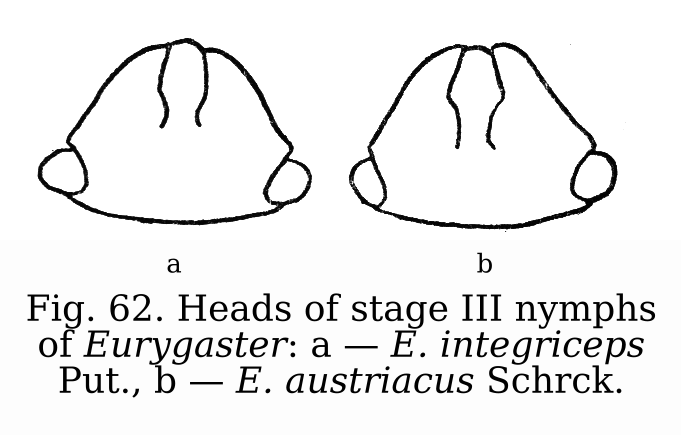
The tylus is not shorter than the jugae, and if it is a little
shorter, it lies almost in the same plane with them, completely open in
front (Fig. 62, a). 2
In the main corners of the shield
rudiment, a smooth callous spot is located.
3
The main corners of the shield rudiment without smooth callous spots.
E.
dilaticollis
The lateral edges of the pronotum
are barely perceptibly (I) or perceptibly (IV–V) curved; the ridge
bordering the edges of the jugae is thin and almost twice as low as in
the following species. E. integriceps
The lateral edges of the pronotum in larvae of all stages are
straight, in older ones they are sometimes slightly concave. The ridge
bordering the jugae is higher and thicker than that of E. integriceps.
E. maurus
& E. testudinarius
Eurygaster austriacus (Schranck, 1778)
Southern broad-bellied bug
= Cimex austriacus Schranck, 1778
Eurygaster integriceps Puton, 1881
Eurygaster dilaticollis Dohrn, 1860
Eurygaster maurus (Linné, 1758)
= Cimex maurus Linné, 1758
= Eurygaster maurus f. meridionalis Péneau, 1911
Eurygaster testudinarius (Geoffroy, 1785)
= Eurygaster maura f. borealis Péneau, 1911
The proboscis is not thick, often
thin; the labrum is attached to the top of the head, and the base of the
proboscis is slightly shifted backwards (Fig. 21, 4).
2
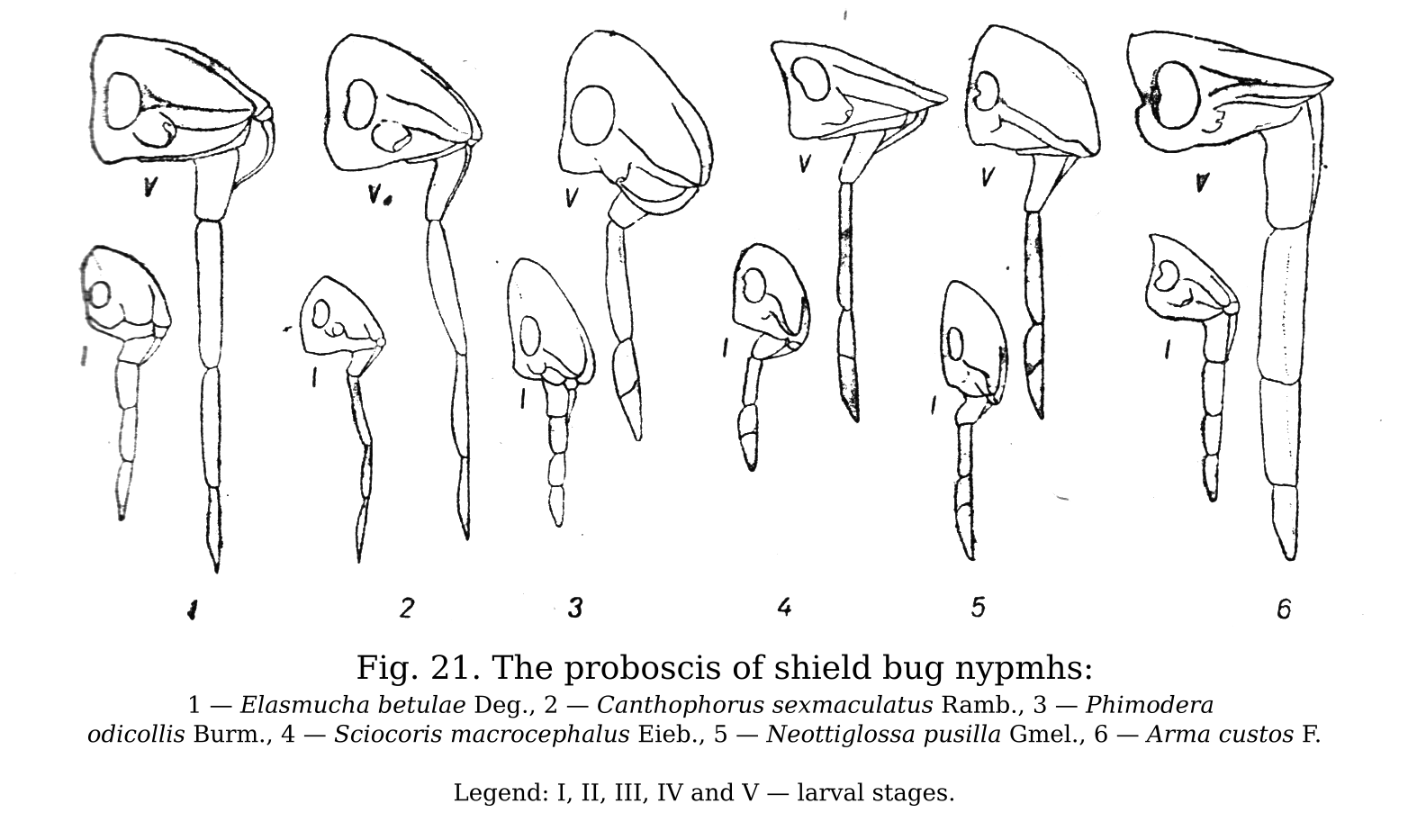
The proboscis is very thick; the bases of the proboscis and labrum
are conjoined and attached to the top of the head (Fig. 21, 6).
Asopinae
The ostioles of all abdominal glands
are split in two, the distance between the openings of the second pair
does not exceed ¼–⅕ (younger stages) or ⅐–⅒ (older stages) of the
greatest width of the abdomen (only in Podops it approaches ⅕). The head
is usually strongly inclined, and the abdomen is without black
punctuation, all parts of the body are almost equally light (II–V) or
(Graphosomini), the distance between the ostioles of the first pair is
greater than between the holes of the second pair.
Podopinae
The ostioles of the abdominal glands are more widely spaced, and the
interval between the openings of the second pair usually does not exceed
⅓ (younger stages) or ⅓–¼ (older stages) of the width of the abdomen.
The head is more often almost horizontal or slightly tilted, and if it
is tilted strongly, then abdomen with deep black punctuation. The head
and thorax in I–III, and often in IV–V (at least partially) stages are
darker than the abdomen, and the distance between the ostioles of the
first pair is not greater (with the exception of Bagrada) than between
the holes of the second pair. Pentatominae
Podopinae Dallas, 1851
Turtle bugs
= Graphosominae Puton, 1879
= Podopides Amyot & Serville, 1843
= Graphosomatini Jakovlev, 1884
The distance between the ostioles of
the first abdominal gland is much wider than on the second ESES. The
first ESES is split in two, in the form of two ovals (Fig. 23, 5)
(Ancyrosomini). 2
The distance between the ostioles of the first abdominal gland is not
wider or slightly wider (Graphosomini) than on the second ESES. The
first ESES is continuous. 4
The body is covered with hairs.
Abdomen above with two broad velvety brown stripes.
Tholagmus
The body is completely bare. Abdomen without longitudinal brown
stripes. 3
The back and front corners of the
abdominal segments are elongated in the form of sharp spines (Fig. 35,
3) (II–V). Ancyrosoma
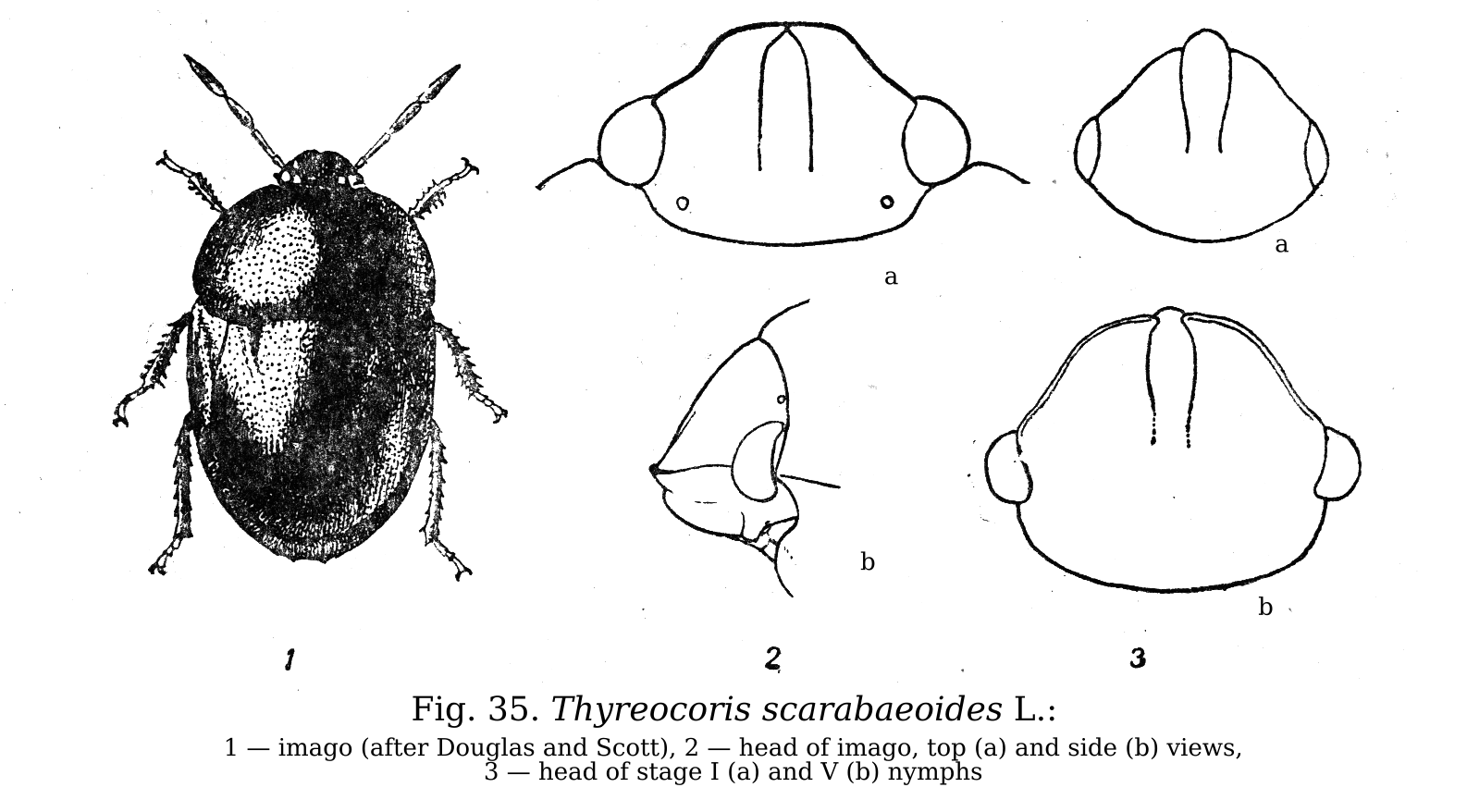
The outer edge of the abdominal rim is notched, but the corners of
the segments are not spiked (Fig. 76, 2) (II–V).
Sternodontus
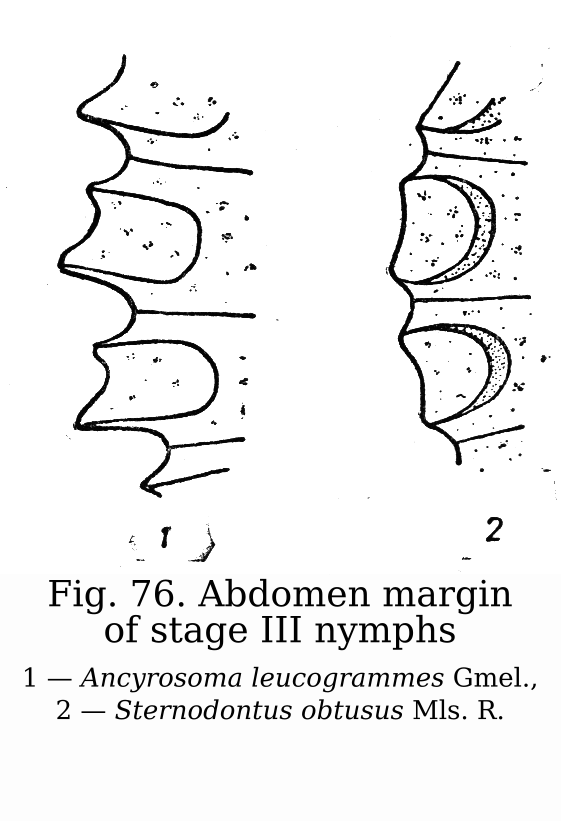
The body is green, spherical. The
ostioles of the first gland are without dark dots and are more narrowly
spaced than those of the other glands; one black dot is placed near the
ostioles of the second and third ESESs. Abdomen without dark
punctuation. On halophytes. Tarisa
The body is of a different color, non-spherical (except for
Vilpianus), if the abdomen is greenish or bluish-green, then there are
paired black dots near the ostioles of the second and third ESESs. Not
found on halophytes (except Trigonosoma halophilum Jak.).
5
There is a large black dot near the
ostioles of all scent glands (only in Trigonosoma trigonum Kryn. the
openings of the first site with brown, sometimes unclear spots). The
distance between the dots near the openings of the first ESES is not
narrower than between the dots of the second, or the ESESs are much
darker than the abdomen. 6
Ostioles of the first abdominal gland without black dots, the
distance between the openings is smaller than between the black dots
located near the second and third glands. The head, thorax, abdomen and
ESESs on it are light (Podopini). Podops
ESESs are the same color as the
abdomen, and black dots near the ostioles of the abdominal glands stand
out sharply against a light background. The distance between the
ostioles on the first ESES is not greater than on the second. The body
is often almost monochromatic, light or dark gray (Trigonosomini).
7
ESESs (Fig. 23, 6) are much darker than the main color of the abdomen
or (at least in older stages) with a dark border; black dots near the
ostioles are not easily visible. The distance between the ostioles of
the first abdominal gland is greater than on the second ESES. The head
and thorax are usually darker than the abdomen (Graphosomini).
10
The body is almost spherical, with
six tubercles on the mesonotum, dark gray (II–V). Legs with with thick
whitish spines (II–V), and trochanters with tubercles (IV–V).
Vilpianus
The body is non-spherical, without tubercles on the mesonotum, the
abdomen is lighter (II–V). Femurs and tibiae without spines, and
trochanters without tubercles (II–V). 8
Smaller. The abdominal rim is
bordered by a rounded whitish ridge (III–V). The head and thorax are
dark brown (I–III) or with remnants of dark color in the form of blurred
stripes (IV–V); dark spots near the ostioles of the second and third
glands are split in two. Crypsinus
Larger. Abdominal rim without a rounded ridge along the edge. The
whole body is almost (II–III) or completely (IV–V) monochromatic, or the
dark spots near the ostioles of the second and third glands are
continuous. 9
The body is very convex. The outer
edge and bottom of the abdomen with light bristles or there are paired
dots near the ostioles of the posterior glands.
Trigonosoma
The body is less convex, completely bare; there is one black dot near
the ostioles of all glands. Leprosoma
The head is dark, almost black
(I–V), and if it is brown (V), then in the main corners of the shield, a
white bump stands out sharply, and there are no longitudinal dark
stripes on the thorax (IV–V). Derula
Head yellowish with a broad black stripe extending along its middle
from apex to base (I–V); in older stages, this stripe in the main half
is often split by a longitudinal light stroke; less often, the head is
almost completely light (II–V). There are no white tubercles in the main
corners of the scutellum (I–V), and the thorax is paler above, with two
very broad black stripes on either side of the median light line (I–III)
or with six dark stripes that converge at the apex of the scutellum (IV
–V) (Fig. 78, 3); less often, the thorax is light, except for blurred
dark stripes (II–V). Graphosoma

Tarisini Stal, 1872
Tarisa Amyot & Serville, 1843
Tarisa pallescens Jakovlev, 1871
Tarisa fraudatrix Horvath, 1891
= Tarisa subspinosa var. fraudatrix Horvath, 1891
Trigonosomini Stal, 1872
Trigonosoma Laporte de Castelnau, 1832
The abdomen is covered with light
long bristles along the edge. Lives on Alyssum.
T.
philalyssum
Margin of abdomen without light long bristles. Lives on other plants.
2
The abdomen is grayish-green. Lives
on halophytes. T.
halophilum
The abdomen is greenish-bluish. Lives on Nigella.
T.
trigonum
Trigonosoma trigonum (Krynicki, 1871)
= Scutellera trigona Krynicki, 1871
Trigonosoma halophilum Jakovlev, 1874
Trigonosoma philalyssum Kiritshenko, 1916
Leprosoma Baerensprung, 1859
Leprosoma inconspicuum Baerensprung, 1859
Crypsinus Dohrn, 1860
Crypsinus angustatus (Baerensprung, 1859)
= Eusarcoris angustatus Baerensprung, 1859
Vilpianus Stal, 1860
Vilpianus galii (Wolff, 1802)
= Cimex galii Wolff, 1802
Ancyrosomini
Ancyrosoma Amyot & Serville, 1843
Ancyrosoma leucogrammes (Gemlin, 1789)
= Cimex albolineatus Fabricius, 1781
= Cimex leucogrammes Gmelin, 1789
Sternodontus Mulsant & Rey, 1856
Sternodontus obtusus Mulsant & Rey, 1856
= Sternodontus obtusus var. debilicostis Puton, 1884
Tholagmus Stal, 1860
Tholagmus flavolineatus (Fabricius, 1798)
= Cimex flavolineatus Fabricius, 1789
Graphosomini Stal, 1872
Graphosoma Laporte de Castelnau, 1832
Striped shield bugs
The head is wide; the jugae cover
the apex of the tylus very little (IV) or almost completely (V), always
leaving a narrow gap. The spiracles are wide and dark.
G.
lineolatum
The head is narrower and longer; the jugae cover the apex of the
tylus almost halfway (IV) or completely (V) anteriorly, leaving no gap.
The spiracles are narrower and lighter. G. semipunctatum
Graphosoma lineolatum (Linné, 1758)
European striped shield bug
= Cimex lineatus Linné, 1758
Graphosoma lineolatum f. italicum (Müller, 1766)
= Cimex italicus Müller, 1766)
Graphosoma semipunctatum (Fabricius, 1775)
North African and Sicilian striped shield bug
= Cimex semipunctatum Fabricius, 1775
Derula Mulsant & Rey, 1856
Derula flavoguttata Mulsant & Rey, 1856
Podopini Stal, 1872
Podops Laporte de Castelnau, 1832
The body is thinly and sparsely
punctuated. Tylus longer than the jugae and uncovered open in front
(I–V). P.
inuncta
The body with dense (especially on the abdomen), black punctuation.
Tylus shorter than the jugae (III–V) and is largely (IV) or almost
completely (V) covered in front. P. incerta
Podops inuncta (Fabricius, 1775)
European turtle-bug
= Cimex inuncta Fabricius, 1775
Podops incerta Horvath, 1883
Pentatominae Stal, 1864
The head is wide, rounded in front,
the jugae and lateral edges of the pronotum are plate-like, very wide.
The body is bare, of a regular oval shape, evenly and slightly convex
above in the thorax and abdomen (side view), and if it is more convex in
the abdomen, it is solid gray (Sciocorini).
2
The head is of a different shape, and the jugae are not wide and not
flattened (except for Holcostethus). The body is often ovoid and
strongly convex in the abdominal area, but then it is not gray, and if
it is of a regular oval shape, it is strongly convex (Neottiglossa,
Rubiconia) or hairy (Staria). 4
The edges of the head and pronotum
are covered with bristles (II–V). Menaccarus
The edges of the head and pronotum are without bristles.
3
The body is of regular oval shape,
slightly convex and non-monochromatic gray.
Sciocoris
The body is ovoid, strongly convex in the abdominal area (II–IV) or
broadly oval (V), gray with thick black punctuation (II–V).
Dyroderes
The head is strongly arched forward.
The jugae are long, pointed at the top and, although even in stage II
they are longer than the tylus, they leave its top open from the front
even in stage V, not covering it from the sides (Fig. 104, 2). Black
stripes on tergites I and II are clear, equal in width to the first ESES
(II–III). Only on Poaceae (Aeliini and Rubiconia).
5
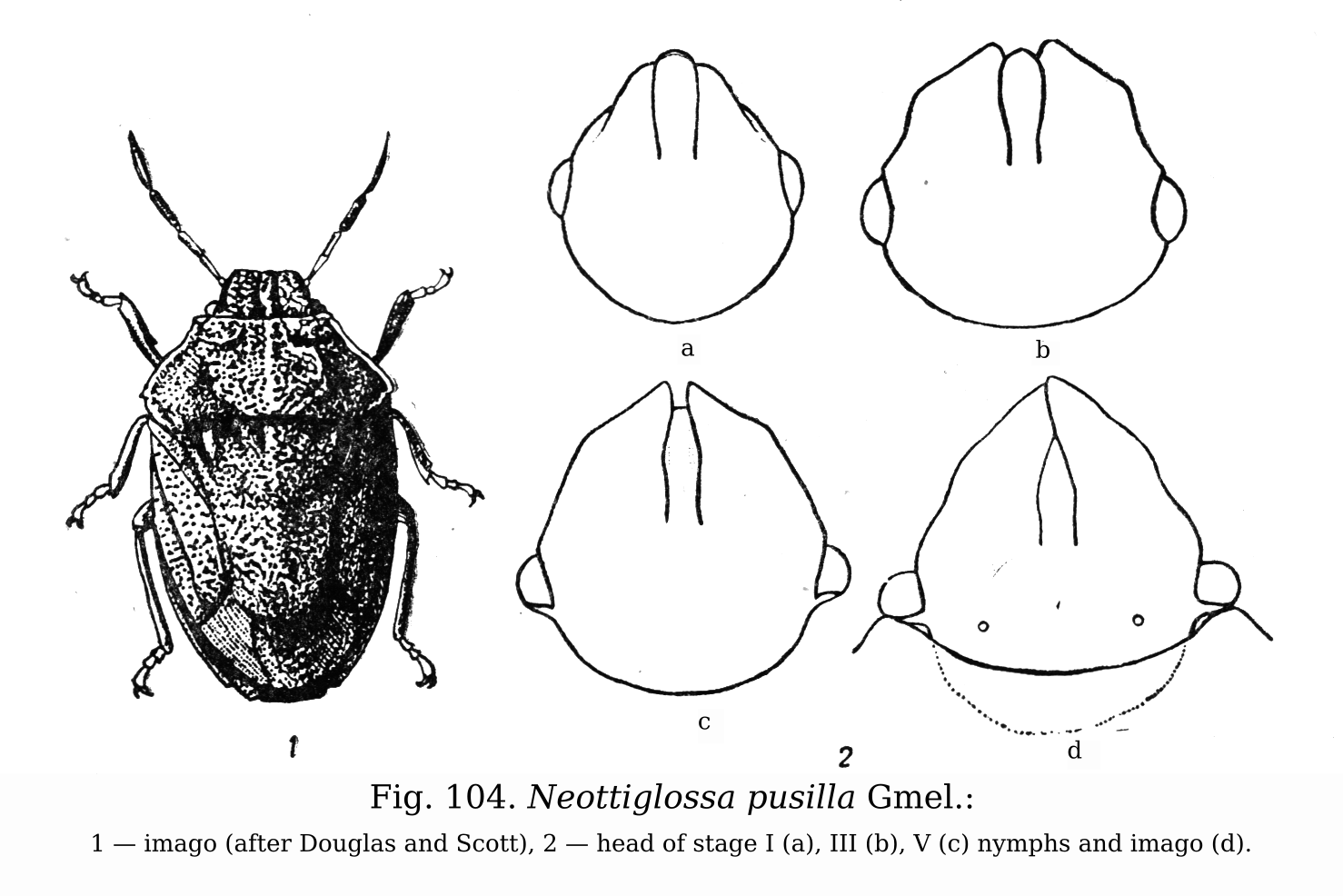
The head is moderately inclined or almost horizontal in front. The
jugae are moderately elongated, blunted at the top, not beyond the
tylus, if they are longer (older stages), they strongly cover its top
from the sides, sometimes covering it from the front as well. On
tergites I and II there are no black stripes, or they are very narrow
and thin. 7
The body is strongly elongated, with
longitudinal dark stripes passing from the thorax to the abdomen (Fig.
99, 2). The outer edges of the jugae near the middle are not curved or
slightly angularly curved, and the head has the appearance of an
elongated triangle. Aelia
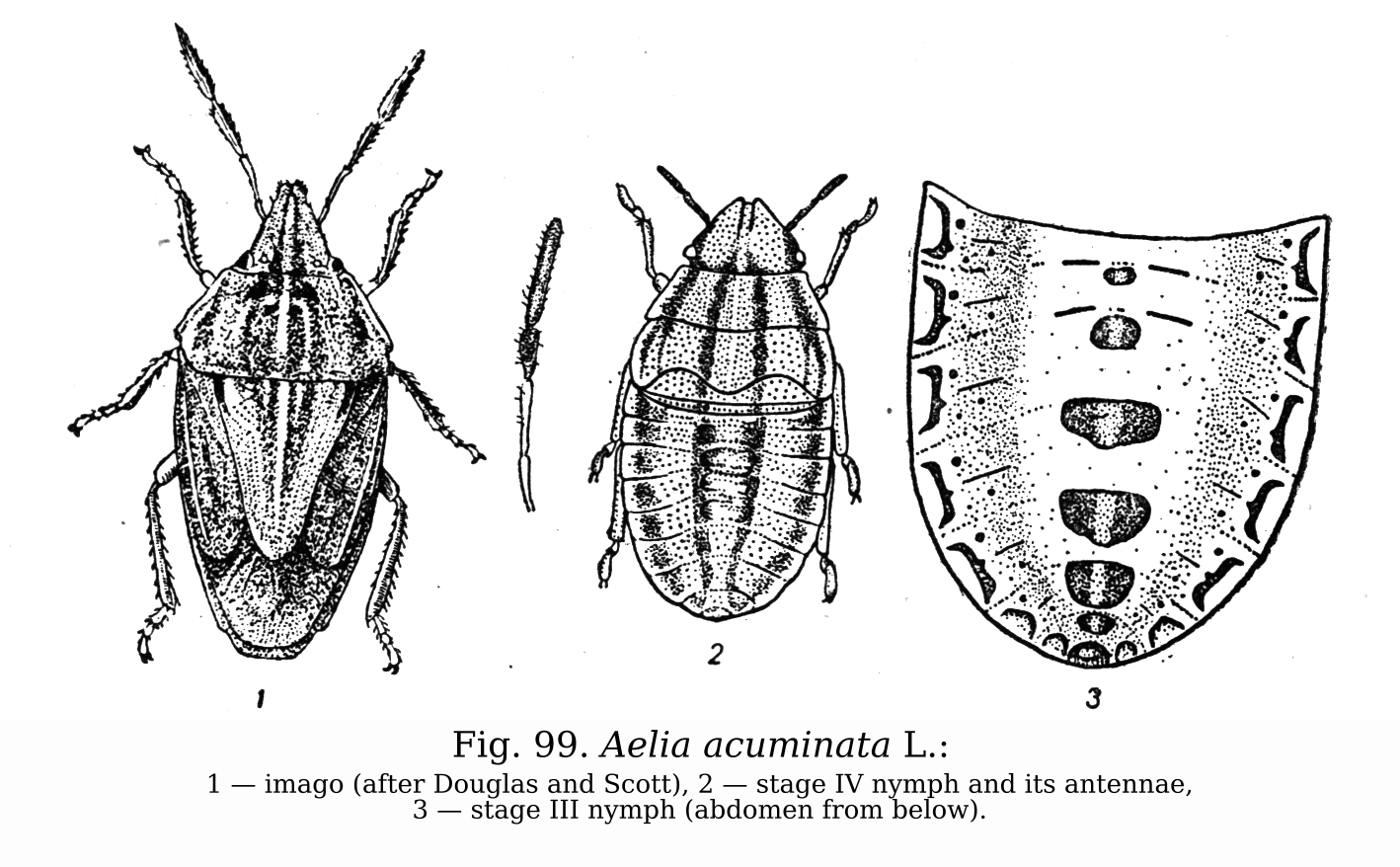
The body is moderately elongated or broadly oval, without dark
longitudinal stripes on the abdomen. The outer edges of the jugae near
the middle are sharply curved, forming an obtuse angle; the head has the
outline of a pentagon (Fig. 104, 2). 6
The width of the dark spots located
below on abdominal sternites VI–VIII is no more than twice their length
(III–V). Light oblong spots in the main corners of the shield are almost
parallel to the middle line of the body or the thorax is almost
completely light from above (III–V). The body is elongated oval,
smaller. Neottiglossa
The width of dark spots on abdominal sternites VI–VIII is more than
twice (on sternite VI three times) their length (III–V). Light elongated
spots in the main corners of the shield are directed at an angle of 45°
to the midline of the body (IV–V). The body is wide oval, large.
Rubiconia
The distance between the ostioles on
the first ESES is only slightly narrower than the width of the ESES
(I–V) (Fig. 124). The dark spot behind the third ESES is completely
shifted to tergite VII, small, blurred or completely absent (II–V). The
edges of the head and thorax are not bordered by a rounded ridge (I–V).
8
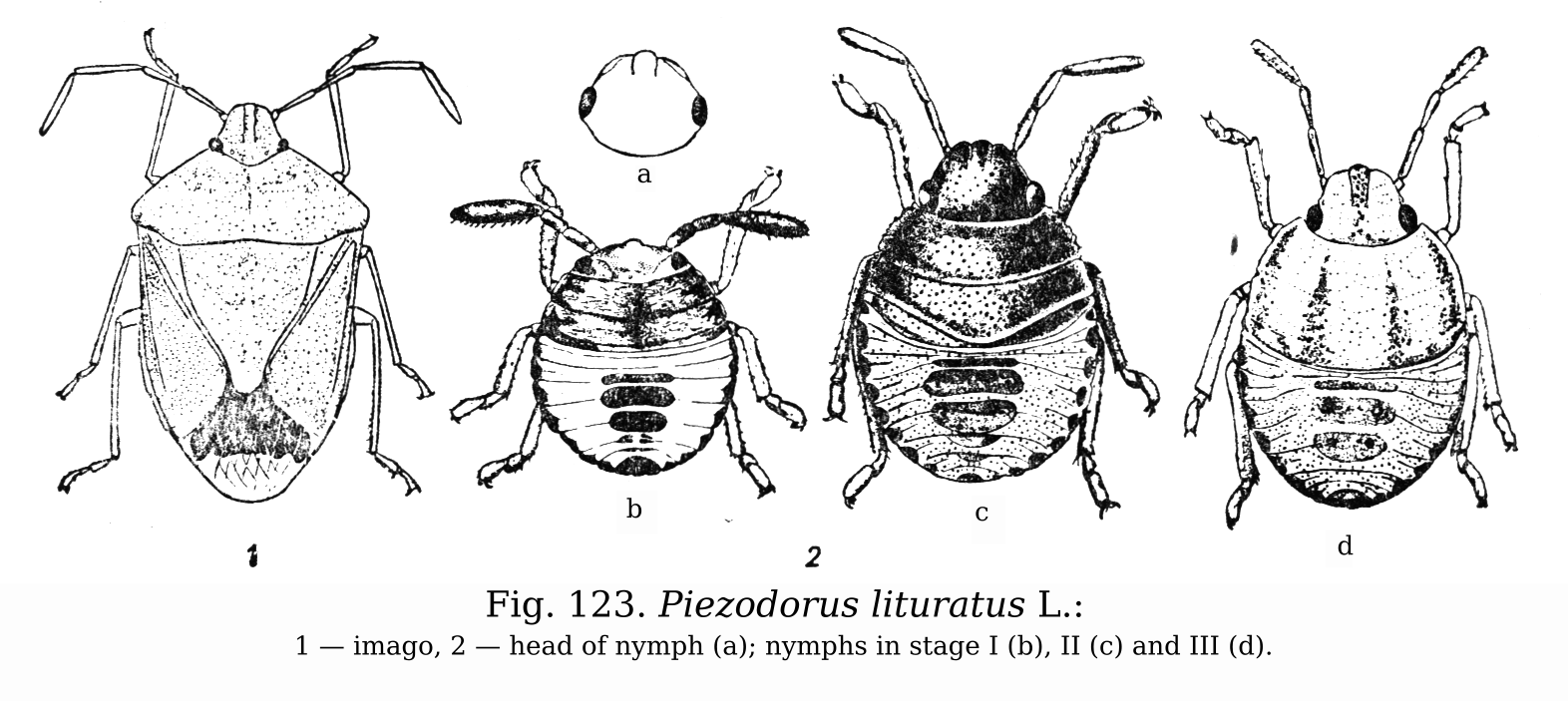
The distance between the ostioles on the first ESES is two to three
times smaller than the width of the ESES (I–V) (Figs. 68, 69). The dark
spot behind the third ESES is large, sharply defined, located on
tergites VI and VII (II-V). The edges of the head and thorax are
bordered by a thick rounded ridge (II–V) (Eurydemini).
23
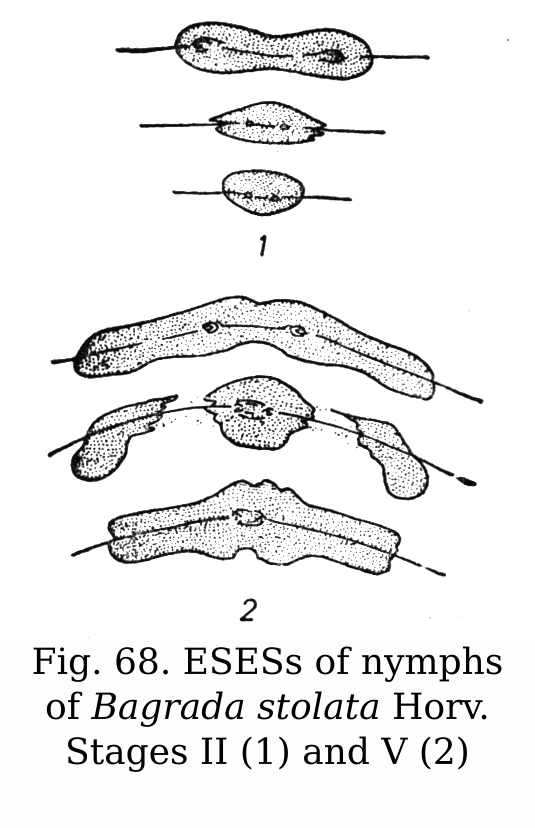
The body is ovoid (I–IV) or oval
(IV–V) with slightly flattened lateral edges of the pronotum. Abdomen
distinctly with protruding hairs that are longer (I), slightly shorter
(II), or significantly shorter (III) than the thickness of the second
segment of antennae, or bare (IV–V). The first ESES looks like an
elongated figure eight, often interrupted in the middle, and the second
usually occupies no more than ⅓–⅙ of the width of the abdomen. Larvae of
small species (Stolliini). 9
The body is almost round (I–II) or broadly oval (III–V), less often
ovoid, but then the lateral edges of the pronotum are strongly flattened
(II–III). The abdomen is bare or covered with long hairs. The first ESES
has the form of a transverse strip, continuous or blurred, but not
interrupted in the middle, and the second usually occupies up to ⅓–⅕ of
the width of the abdomen. Mostly larvae of large species (Pentatomini).
10
The spots on the VI–VIII sternites
in the middle of the lower surface of the abdomen are almost square in
shape, and the largest is located on the VII sternite (II–V) (Fig. 105,
3). Abdomen without black depressed punctuation, and if it is present
(IV–V stages of S. amoenus), it is small, with a large admixture of dots
of a different color that are not depressed in the integument.
Stagonomus
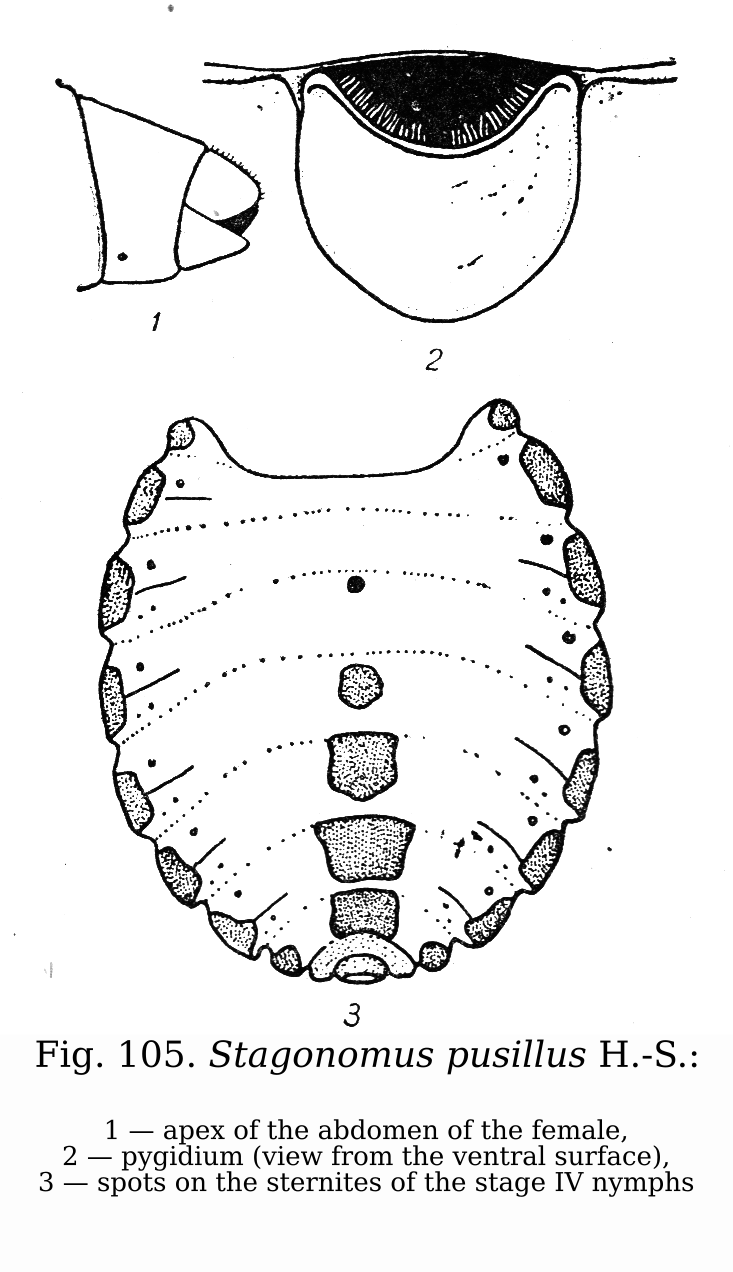
The width of the spots placed in the middle (VI–VII) of the sternites
on the lower abdomen is more than twice as long as the length. The
largest spot is located on the sixth sternite (II–V) (Fig. 108), and if
they are not so wide (S. venustissima), then the ESESs are completely
black (II–V). The abdomen is punctuated less (II–III) or more (IV–V)
with large and densely placed black depressed points, without an
admixture of points of a different color not depressed in the abdominal
cover. Stollia

Abdomen without black spots placed
on the sides in longitudinal rows. 11
Rows of rounded spots run along the abdomen, dorsally one row on each
side and ventrally two on each side (II–V). The abdomen is pinkish or
crimson, completely unpunctuated, with long hairs (II–V) on the bottom
and on the edge. Codophila
The body is covered with hairs on
top. 12
The body is completely bare from above (only in the younger stages,
short hairs sometimes stick out on the head and the edges of the
pronotum). 15
The hairs on the body are long and
very densely placed. Dark spots and stripes on the body are not sharply
outlined, but blurred. 13
The hairs on the body are short, if longer then sparsely placed. Dark
spots and stripes on the body are sharply defined, often almost not
blurred even in older stages. 14
The spots on the abdominal margin
are very large, the width of the spot on tergite IV almost equals the
distance from its inner edge to the second ESES. The body is very
convex, the hairs are long. Small larvae. Staria
The spots on the abdominal margin are smaller, extending beyond the
borders of the paratergites, the width of the spot on tergite IV is two
to four times smaller than the distance from its inner edge to the
second ESES. The body is moderately convex, the hairs are short. Larvae
of larger species. Dolycoris
The hairs on the body are shorter
than the thickness of the segments of the antennae. The head is almost
semicircular from the front (II–V), the jugae are wide, flattened,
almost (IV) or completely (V) cover the top of the tylus, only in H.
sphacelatus does it remain uncovered. Holcostethus
The hairs on the body are much longer than the thickness of the
segments of the antennae. The head is trapezoidal from the front, the
jugae are not longer than the tylus (II–V).
Antheminia
Abdomen above without large whitish
or yellowish rounded spots placed in longitudinal rows.
16
Abdomen from above with large rounded whitish or yellowish spots
arranged in four longitudinal rows along the inner edges of the
abdominal rim and on both sides of the midline of the body (Fig. 123).
Nezara
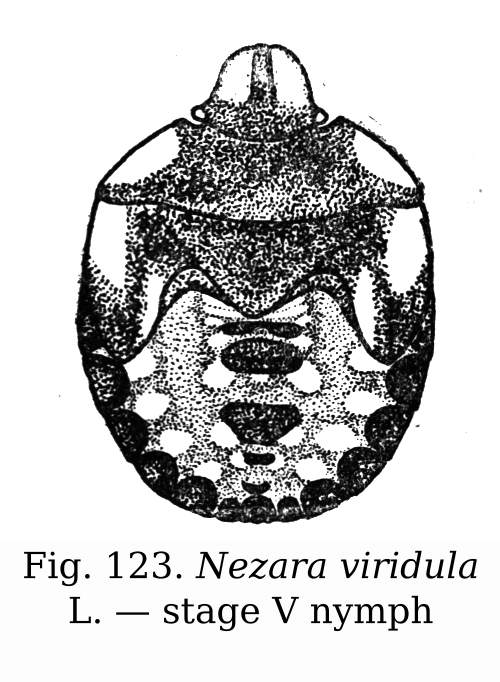
There are no black spots on the
sides of the abdomen, at the level of the gaps between the ESESs.
17
On the sides of the abdomen, at the level of the gaps between the
first and second and the second and third ESESs, black spots (V) stand
out sharply. The body is green. Acrosternum
On coniferous trees and shrubs. The
abdomen is black with two light spots on the sides (I–II) or off-white,
greenish or dark purple, dotted with unimpressed, vague crimson or
blackish spots (III–V). There are no black spots on the abdominal margin
below in the rear corners of the segments.
Pitedia
Not found on conifers. Abdomen of a different color, and if green,
then with sharp spots from below in the rear corners of the segments or
with clear black depressed punctuation. 18
The abdomen is green, without
crimson stripes at the joints of the segments (I–V), but with large
black spots below, in the rear corners of the segments.
19
The abdomen is of a different color (I–V), and if it is greenish,
then with crimson stripes at the joints of the tergites and without
black spots near the rear corners of the segments of the abdominal rim
(II–V) (Fig. 124, 2). 20
The abdomen has thin black
puncutation (I–V). The outer edge of the abdominal rim is clearly uneven
(Fig. 122, 5), below with a large black spot near the anterior and
posterior corners of the segments (III–V).
Palomena
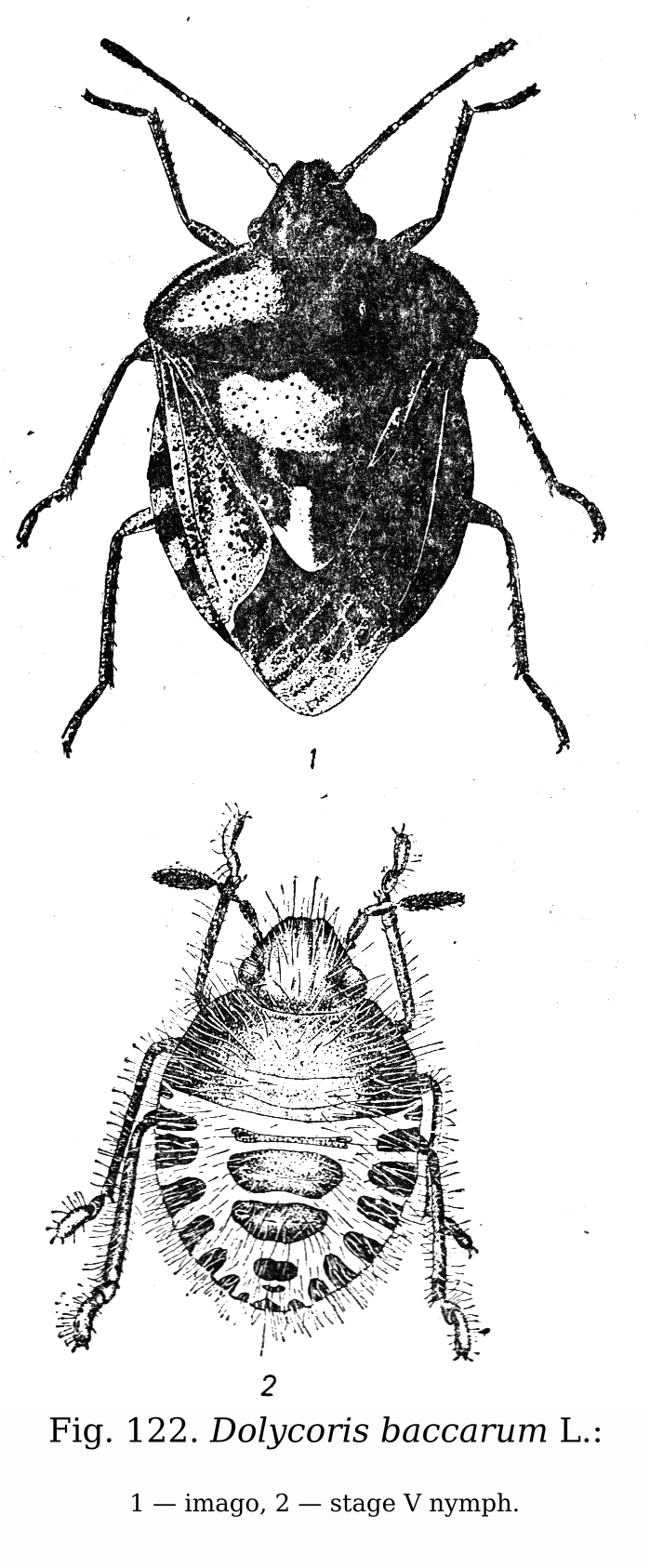
The abdomen has colorless punctuation, with a fairly even outer edge
of the abdominal rim (I–V), below with a whitish black spot near the
rear corners of the segments (II–V). Brachynema
Abdomen above with a bright curved
red transverse band (I–IV) or four black or brown broken stripes along
the upper surface of the thorax (IV–V). All dark areas of the body in
the older stages have a strong metallic sheen (bronze, blue, green), and
the black dotted points on the abdomen are placed only in clusters.
Carpocoris
Abdomen without a red transverse stripe (I–V), thorax from above
without longitudinal dark stripes, and if they are present, they are not
broken and without a metallic sheen (II–V); the abdomen is rather
uniformly punctuated (II–V). 21
Abdomen crimson (I–II) or dirty
green with crimson stripes between the tergites, without black spots
near the corners of the segments (different from Palomena) (II–V).
Longitudinal stripes on the head and thorax are wide, black-brown
(III–V) (Fig. 124, 2). Punctuation of the body is uniform and finer than
in the following species. Piezodorus
Abdomen is gray, dirty gray (with a pink tinge in stages I–II) or
brown. There are no longitudinal stripes on the head and thorax. The
punctuation of the body is very large and thick, in some places the dots
merge into small spots. 22
Antennae are brown or black with
whitish joints, and in the older stages, with whitish bases of the third
and fourth (often also the second) joints. Larvae occur from June
(hatching) to August (ewetting). Rhaphigaster
Antennae are brown or black in all stages, with reddish joints in
younger ones. Larvae occur from August to September (rebirth) to July
(ewetting); hibernate in stages II–III. Pentatoma
The distance between the holes on
all ESESs is almost the same (I–V) (Fig. 69). The first evaporation
platform is sickle-shaped (II–V). Eurydema
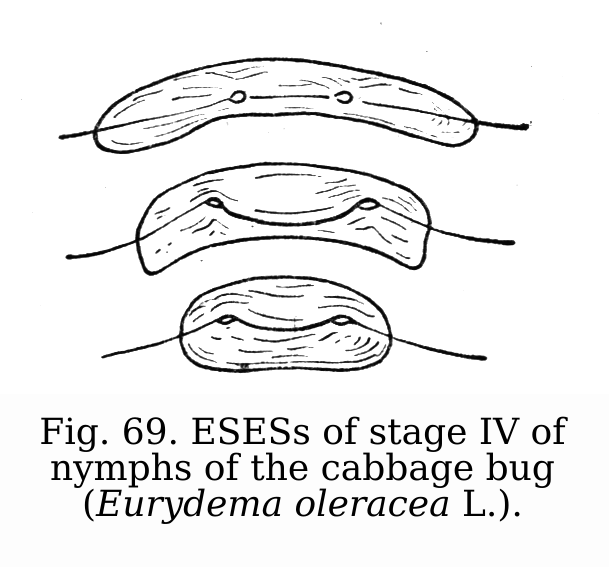
The distance between the holes on the second and third ESESs is
several times smaller than on the first ESES (I–V) (Fig. 68). The first
ESES is not sickle-shaped. Bagrada
Sciocorini Stal, 1872
Menaccarus Amyot & Serville, 1843
Menaccarus arenicola (Scholtz, 1846)
= Sciocoris arenicola Scholtz, 1846
Sciocoris Fallén, 1829
Body with a distinct black pattern
on a white background (II–IV) or at least with remnants of it on the
head and thorax (IV–V). ESESs are sharply outlined in all stages and
always without light spots near the ostioles of the second and ESESs.
2
The head and thorax are black (II–III), less often light brownish
with a dark pattern (stages II–III of S. distinctus) or the whole body
is dull (brown, brownish-red, dirty gray, etc.) with blurred dark spots
and stripes (IV–V) . ESESs in older stages are blurred, always with
light elevations near the ostioles of the second and third ESESs.
3
Body with thinly scattered
punctuation. The dark pattern is clearly expressed in all stages. The
abdominal margin is bordered by a wide light band separating the
paratergite and parasternite spots. S. macrocephalus
Body with large and dense punctuation. The dark pattern in older
stages is strongly blurred. The abdominal margin is bordered by a very
narrow light stripe. S. homalonotus
There is a dark spot in the top
corners of the shield, and four dark longitudinal stripes run along the
thorax (stages IV–V; stages I–III are unknown).
S.
sulcatus
The top corners of the shield are without dark spots, and the dark
longitudinal stripes on the thorax are indistinct.
4
The lateral edges of the pronotum
are black (I–III), and if more or less light, then not lighter than its
disc (IV–V). Dark spots located on the upper and lower sides of the
abdominal margin merge at its edge; the spots in the middle of the
abdomen below are solid. The body is finely punctuated or the head is
very broad. Not related to Poaceae. 5
The lateral edges of the pronotum are light, always lighter than the
disc (II–V). The dark spots do not merge along the edge of the abdominal
margin, but are separated by a light stripe (I–V); the spots in the
middle of the abdomen are separated from below by a longitudinal light
stripe (IV–V). The body is coarsely punctuated, and the width of the
head is not greater than the length. Closely related to Poaceae.
S.
distinctus
The body in all stages is matte, not
as wide and large as in the next species, and punctuated with small
dots. The eyes are half set into the head, and the width of the head is
slightly greater than the length (III–V). Widespread everywhere.
S.
cursitans
The body is strongly (I–II) or moderately (IV–V) shiny, wider and
larger, puntuated with large dots. The eyes are set into the head by at
least ⅔ (III–IV) or almost do not protrude beyond the edges of the jugae
(V); head width much larger than length (II–V). Found only in the south.
S.
deltocephalus
Sciocoris deltocephalus Fieber, 1861
Sciocoris cursitans (Fabricius, 1794)
Sand-runner shieldbug
= Naucoris cursitans Fabricius, 1794
Sciocoris macrocephalus Fieber, 1851
Sciocoris sulcatus Fieber, 1851
Sciocoris homalonotus Fieber, 1851
Sciocoris distinctus Fieber, 1851
Dyroderes Spinola, 1837
Dyroderes umbraculatus (Fabricius, 1775)
= Acanthia umbraculata Fabricius, 1775
Aeliini Stal, 1872
Aelia Fabricius, 1803
The whole body is densely covered
with short light hairs sticking out from brown or black dots.
A.
acuminata
The thorax and abdomen are bare or covered with long scattered hairs.
2
The head and thorax without hairs or
with only very short hairs (shorter than the thickness of the antennae)
on the top of the head. 3
At least the entire surface of the head is covered with long hairs
(twice as long as the thickness of the joint of the antennae). Dark
stripes and spots on the body are wide, sharply defined.
A.
virgata
Head and thorax with sharply defined
black longitudinal stripes. The head is shorter; the outer edges of the
jugae are bent inward in the form of an obtuse angle. The tops of the
jugae, bending towards each other, slightly cover the top of the tylus.
4
Longitudinal stripes on all parts of the body are not clearly
defined, often they are very blurred. The head is much longer; the outer
edges of the jugae are slightly curved near the middle (II–III) or
straight (IV–V). The upper parts of the jugae are almost parallel; tylus
wide open in front (I–V). A. rostrata
The ESESs are sharply delineated,
black. Usually, the abdomen is evenly, sparsely punctuated, without dark
longitudinal stripes. A forest species, more common in the west of the
Ukrainian SSR. Smaller in size. A. klugi
The ESESs are not so sharply defined, blurred. Abdomen with four to
six blurred dark longitudinal stripes, covered with black dots, and in
the spaces between them light punctuation. A steppe species, more common
in the east of the Ukrainian SSR. Larger in size.
A.
sibirica
Aelia acuminata (Linné, 1758)
Bishop's mitre shield bug
= Cimex acuminatus Linné, 1758
Aelia klugi Hahn, 1831
Aelia sibirica Reuter, 1886
Aelia rostrata Boheman, 1852
Aelia virgata Klug in Herrich-Schäffer, 1841
Neottiglossa Kirby, 1837
The abdomen is red (I–III), and if
whitish, then with a reddish tint between the ESESs (III–V). The head
and thorax are black (I–III) or the thorax with three more or less
narrow longitudinal whitish stripes (IV–V). Dots on the thorax are
larger than on the abdomen (II–V). N. leporina
The abdomen is yellow (I–II), and if whitish, then with an ocher tint
between the ESESs (III–V). The head and thorax are black (I–III) or
almost completely light brown (III–V). Dots on the abdomen are as large
as on the thorax (II–V). N. pusilla
Neottiglossa leporina (Herrich-Schäffer, 1830)
= Pentatoma leporina Herrich-Schäffer, 1830
Neottiglossa pusilla (Gmelin, 1789)
Small grass shieldbug
= Cimex pusillus Gmelin, 1789
= Neottiglossa seorsa Jakovlev, 1903
Stolliini
= Eysarcoraria Stal, 1872
Stagonomus Gorski, 1852
The body is not elongated; antennae
and legs dark brown or brown (I–V). The lateral edges of the thorax are
dark, not lighter than the disc (II–V); pronotum often bright in front
(II–IV). Abdomen without black stippling (I–V).
S.
pusillus
The body is elongated; antennae and legs are black (I–IV) or almost
brown with black bands on the thighs (IV–V). The lateral edges of the
thorax are always lighter than the disc (II–V), and the pronotum is not
lighter anteriorly than posteriorly (II–V). The abdomen is punctuated
with black dots (IV–V). S. amoenus
Stagonomus pusillus (Herrich-Schäffer, 1830)
= Cimex pusillus Herrich-Schäffer, 1830
Stagonomus amoenus (Brulle, 1832)
= Pentatoma amoena Brulle, 1832
= Cimex bipunctatus Fabricius, 1781
= Cimex italicus Gmelin, 1789
Stollia Ellenr., 1862
The largest sternite spot is located
on sternite VI, its width is more than twice the length (II–V).
2
The largest sternite spot is located on sternite VII, its width is
less than twice the length (II–V). The abdomen is sparsely punctuated
with small black dots and has yellowish stripes between the tergites.
S.
venustissima
The body is green. Abdomen with
rather fine black punctuation, without red stripes between tergites
(II–V). S.
inconspicua
The body is not green. Abdomen is densely punctuated with large black
dots and red stripes between the tergites (II–V).
S.
aenea
Stollia aenea (Scopoli, 1763)
New forest shieldbug
= Cimex aeneus Scopoli, 1763
Stollia venustissima (Schranck, 1776)
Woundwort shield bug
= Cimex melanocephalus Fabricius, 1775
= Cimex venustissimus Schranck, 1776
= Eusarcoris fabricii Kirkaldy, 1904
Stollia inconspicua (Herrich-Schäffer, 1844)
White-spotted stink bug
= Pentatoma inconspicuum Herrich-Schäffer, 1844
Pentatomini Stal, 1872
Staria Dohrn, 1860
Staria lunata (Hahn, 1835)
= Eysarcoris lunatus Hahn, 1835
Rubiconia Dohrn, 1860
Rubiconia intermedia (Wolff, 1811)
= Cydnus intermedius Wolff, 1811
Palomena Mulsant & Rey, 1866
Palomena prasina (Linné, 1761)
= Cimex prasinus Linné, 1761
Palomena viridissima (Poda, 1761)
= Cimex viridissima Poda, 1761
Pitedia Reuter, 1888
The proboscis extends beyond the
middle of the abdomen (II–V). The abdomen is bluish- or greenish-white
above and below (III–V). P. pinicola
The proboscis extends slightly only behind the coxae of the hind legs
(II–V). The abdomen is dark purple above and bright green below (III–V).
P.
juniperina
Pitedia pinicola (Mulsant, 1852)
= Pentatoma pinicola Mulsant, 1852
Pitedia juniperina (Linné, 1758)
= Cimex juniperinus Linné, 1758
Holcostethus Fieber, 1860
The tylus is covered or almost
covered in front by the jugae (IV–V). 2
The tylus is wide open in front. H. sphacelatus
The fourth segment of the antennae
is light (III–V). H. inclusus
The fourth segment of the antennae is dark brown (III–V).
H.
vernalis
Holcostethus vernalis (Wolff, 1804)
= Cimex vernalis Wolff, 1804
Holcostethus inclusus (Dohrn, 1860)
= Pentatoma inclusus Dohrn, 1860
Holcostethus sphacelatus (Fabricius, 1794)
= Cimex sphacelatus Fabricius, 1794
Carpocoris Kol., 1846
Carpocoris Kolenati, 1846
The mesonotum is equal in width to
the pronotum (IV) or is much narrower than it (V). The head usually has
two longitudinal light stripes. C. fuscispinus
The mesonotum is wider than the pronotum (IV) or equal to it in width
(V). The head is completely dark. C. pudicus
Carpocoris fuscispinus (Boheman, 1894)
Northern fruit bug
= Cimex nigricornis Wolff, 1804
= Cimex fuscispinus Boheman, 1894
Carpocoris pudicus (Poda, 1761)
= Cimex pudicus Poda, 1761
= Cimex purpureipennis De Geer, 1773
Carpocoris melanocerus Mulsant, 1852
Antheminia Mulsant & Rey, 1866
Carpocoris lunulatus (Goeze, 1778)
= Cimex lunulatus Goeze, 1778
= Mormidea lynx Fieber, 1861
Codophila Mulsant & Rey, 1866
Codophila varia (Fabricius, 1787)
= Cimex varius Fabricius, 1787
Dolycoris Mulsant & Rey, 1866
The flattened lateral edges of the
pronotum and hemelytra are punctuated with dark dots. Tylus not shorter
than the jugae. The second segment of the antennae is not reddish.
D.
baccarum
The flattened lateral edges of the pronotum and hemelytra are
punctuated with colorless dots. Tylus is clearly shorter than the jugae.
The second segment of the antennae is often reddish.
D.
varicornis
Dolycoris baccarum (Linné, 1758)
Sloe bug
= Cimex baccarum Linné, 1758
Dolycoris varicornis (Jakovlev, 1874)
= Mormidea varicornis Jakovlev, 1874
Nezara Amyot & Serville, 1843
Nezara viridula (Linné, 1758)
= Cimex viridulus Linné, 1758
Acrosternum Fieber, 1860
Acrosternum heegeri Fieber, 1861
Piezodorus Fieber, 1860
Piezodorus lituratus (Fabricius, 1794)
= Cimex lituratus Fabricius, 1794
Rhaphigaster Laporte de Castelnau, 1832
Rhaphigaster nebulosa (Poda, 1761)
= Cimex nebulosus Poda, 1761
Pentatoma Oliv., 1789
Pentatoma rufipes (Linné, 1758)
= Cimex rufipes Linné, 1758
Brachynema Mulsant & Rey, 1852
Brachynema virens (Klug.)
Eurydemini Dist., 1902
= Strachiaria Stal, 1872
Eurydema Laporte de Castelnau, 1832
Cabbage bugs, caper bugs and allies
= Strachia Hahn, 1831
The abdomen is bright red.
2
The abdomen is ocher, yellowish or whitish.
Dark-colored areas of the body
without a metallic sheen or the sheen is very weak. On the coast of the
Sivash, Azov and Black seas. E. spectabilis
Dark areas of the body with a metallic sheen. Far from the shores of
the seas, on rocky slopes. E. fieberi
Eurydema spectabilis Horvath, 1882
Spectacular cabbage bug
Eurydema fieberi Schummel, 1836
Eurydema ornata Linné
= Eurydema ornatum var. ventrale Kolenati, 1846
Eurydema festiva (Linné, 1758)
= Cimex festivus Linné, 1767
Eurydema dominulus (Scopoli, 1763)
= Cimex dominulus Scopoli, 1763
Eurydema oleracea (Linné, 1758)
= Cimex oleraceus Linné, 1758
Bagrada Stal, 1872
Bagrada stolata Horvath, 1936
Asopinae Spinola, 1850
Predatory stink bugs
Front femurs in the apical half with
a tooth (IV–V) or a tubercle in the form of a hump (III), but even in
the latter case it is larger than the humps on the middle and hind
femurs. 2
Front femurs without a tooth, and if with tubercles, they are not
larger than tubercles on middle and hind tibiae (III–V).
4
The black transverse stripe on
tergite II is wide, almost as wide as the first ESES, and the width of
the paratergite spots is much greater than the length (II–V). Tibiae
with wide light rings that stand out sharply against a dark background
(IV–V). 3
There is no black stripe on tergite II or it is very narrow;
paratergite spots of regular semi-oval shape, equal in length and width
(II–V). Tibiae are black. Jalla
The abdomen is light (I–V), yellow
or (on the sides) grayish. Antennae are dark. Head and thorax with
scattered punctuation. The outer edge of the jugae is concave, and the
tylus is narrowed at the apex (IV–V). Pinthaeus
The abdomen is dark (I–V), crimson (I–IV) or brown (V). Antennae are
dark (I–III) or light, yellowish, only the tops of the last two segments
are black (IV–V). Head and thorax with dense punctuation. The outer edge
of the jugae is straight, and the tylus is not narrowed at the apex
(IV–V). Picromerus
The abdomen is not completely
crimson (I–V), the lateral edge of the pronotum is usually serrated
(III–V). 5
The abdomen is crimson in all stages. The chest is black with a
bluish metallic sheen. The lateral edges of the front back are not
serrated, only slightly wavy. Zicrona
The abdomen is light yellow (I–V)
with three wide longitudinal red stripes (in the middle and on the
sides), which connect at the apex of the abdomen (I–III); if these
stripes are blurred, then the head and thorax are almost completely
yellowish, except for a few dark spots (IV–V).
Arma
The abdomen is darker, from reddish-yellow to reddish-brown, without
red longitudinal stripes (I–V). The head and thorax are completely
black, only the lateral edges of the pronotum and hemelytrae are light.
6
The lateral edges of the pronotum in
front of the posterior corners are light throughout their entire width
and serrated along the very edge (III–V); in older stages, the teeth are
saw-shaped, bent back (Fig. 132). The proboscis goes behind the coxae of
the hind legs or reaches them. ESESs in stage IV–V with incision on the
sides (Fig. 132). Abdomen unpunctuated or with very gentle and fine
punctuation. Troilus

The lateral edges of the pronotum are almost smooth, dark (as is the
disc), bordered by a light yellowish or reddish narrow stripe only in
stage V and barely jagged along the very edge. The proboscis slightly
extends beyond the coxae of the middle legs (II–III) or only reaches
(IV–V) them. ESESs without cutouts on the sides (I–V). Abdomen with
rather dense and large black punctuation (IV–V).
Eysarcoris
Pinthaeus Stal, 1867
Pinthaeus sanguinipes (Fabricius, 1787)
= Cimex sanguinipes Fabricius, 1787
Picromerus Amyot & Serville, 1843
Picromerus bidens (Linné, 1758)
= Cimex bidens Linné, 1758
Troilus Stal, 1867
Troilus luridus (Fabricius, 1775)
= Cimex luridus Fabricius, 1775
Arma Hahn, 1832
Arma custos (Fabricius, 1794)
= Cimex custos Fabricius, 1794
Eysarcoris Hahn, 1831
Eysarcoris punctatus (Linné, 1785)
= Cimex punctatus Linné, 1785
Jalla Hahn, 1832
Jalla dumosa (Linné, 1758)
= Cimex dumosum Linné, 1758
Zicrona Amyot & Serville, 1843
Zicrona coerulea (Linné, 1758)
= Cimex coeruleus Linné, 1758